
www.pacifictenders.com APRIL - JUNE 2024 ISSUE 16




Founder Publisher
Mr. Rodney Rupokets rodney@pacifictenders.com
Business and Marketing
Ms. Namoi Kaluae Solomon Islands
Editor
Mr. Douglas Saefoa Solomon Islands
Contributing Writers
Mr. David Spring Sydney, Australia
Jason Paisoi Port Moresby, PNG
PT Marketing and Research Consultant
Ms. Lorna Bondoc Manila, Philippines
Media and Advertising Enquiries
contact@pacifictenders.com contact@apactenders.com www.pacifictenders.com
n Solomon Islands +677 38229
n Phillipines 63 927-002-3699
Editorial Enquiries media@pacifictenders.com

Published by
Adkonect PO Box 1368 Henderson Courts Building Henderson East Honiara. www.adkonect.com.sb sales@adkonect.com.sb
12 GO BEYOND THE CONFERENCE Build Your Infrastructure Pipeline CONTENTS COVER STORY NZ TRADE MISSION: THE BUSINESS OF EXPORTS 06 09 3.3% GROWTH EXPECTED IN THE PACIFIC REGION IN 2024, 4% IN 2025 — ADB 14 CULTIVATING THOUGHT LEADERSHIP FOR TENDERING SUCCESS 15 FACE PALM: WHEN LABOR MOBILITY ATE THE MARKET 17 NEW PAYMENT SYSTEM 18 AI IN PACIFIC PROCUREMENT, DESPITE INFRASTRUCTURE GAPS 10 INCLUSIVE PROCUREMENT: BUILDING A PIPELINE FOR ALL 25 COMPREHENSIVE PROJECT MANAGEMENT CRUCIAL FOR LARGE-SCALE CONTRACTS: The Naha Birthing and Urban Health Centre Case PT MEET OUR SUPPLIERS 30 34 AUSTRALIA'S AUD 72 MILLION INVESTMENT TRANSFORMS ROADS, BOOSTS MARKETS FOR LOCAL WOMEN 20 MAIN WORKS TO COMMENCE AT NAHA BIRTHING AND URBAN HEALTH CENTRE 26 ADB FINANCES K7.8 MILLION AIRPORT PROJECT IN MILNE BAY 22 HOW PROCUREMENT EFFICIENCIES DRIVE ORGANIZATIONAL EXCELLENCE 27 ENSURING FAIRNESS AND TRANSPARENCY IN EXTRACTIVE PROJECTS 28 SINPF $81 MILLION DOLLAR PROJECT FOR NEW COMMERCIAL BUILDING COMMENCES 29 NISIT FORGE STRATEGIC PARTNERSHIP FOR TECHNOLOGICAL ADVANCEMENT 33 AIFFP LAUNCHES BOAT HARBOUR UPGRADES IN TUVALU 35 2024 PNG RESOURCES WEEK TO UNITE STAKEHOLDERS FOR SUSTAINABLE GROWTH 36 NEW BORDER MANAGEMENT SYSTEM TO ENHANCE SOLOMON ISLANDS' SECURITY AND ECONOMIC GROWTH 38 POWERING HEALTHCARE IN SOLOMON ISLANDS 21 MINISTER BOSAWAI OFFICIATES IN START OF WORK EVENT AT NAHA BIRTHING AND URBAN HEALTH CENTRE
Director
PACIFIC TENDERS EXPANDS TO ASIA WITH NEW WEBSITE LAUNCH
Pacific Tenders is excited to announce the launch of its new website on June 21st, marking a significant milestone as the company expands into the Asian region. This move underscores the company's commitment to growth and innovation, broadening its reach from the Pacific to the dynamic markets of Asia. Since its product development phase in 2021, Pacific Tenders has continued to innovate and enhance its services. The new website will retain key functionalities, including the Tender Alert Service, Buyer One-Off Advertising, and the exclusive Buyer Portal, ensuring that users continue to benefit from the features they rely on.
Strategic Expansion into Asia Pacific
The strategic expansion into Asia Pacific marks a pivotal milestone in the company’s growth trajectory. The rebrand of Pacific Tenders to APAC Tenders will enable its existing pool of international subscribers in the Asia Pacific region to access a wealth of opportunities and resources in the Asia Pacific market. This move is designed not only to enhance the reach and functionality of our platform but also to provide a seamless user experience that bridges the gap between the Pacific and Asian markets. By expanding into Asia, APAC Tenders aims to unlock new opportunities for our subscribers, facilitating business growth and diversification in the dynamic Asian market. Moreover, this strategic expansion will allow buyers to explore a more extensive and diverse supplier base, ensuring they have the best options available for their procurement needs. The transition from Pacific Tenders to APAC Tenders is designed to be smooth, ensuring improved reach and functionality without any disruptions. By providing enhanced access to opportunities and resources, we aim to level the playing field for our clients, allowing businesses of all sizes to compete more effectively in the Asian market. This initiative will also solidify our position as a leading tendering platform in the Asia Pacific region, driving further growth and innovation.
Market Potential in Asia
The Asia Pacific procurement market is a significant segment of the global economy. Valued at USD 1.9 trillion in 2022, this market is projected to reach USD 3.1 trillion by 2028, representing a Compound Annual Growth Rate (CAGR) of 8.2% during the forecast period (2023-2028). This substantial growth reflects the dynamic economic environment of the region, driven by both public and private sector investments. Government procurement accounts for a significant portion of this market, with countries like China and India being major contributors. Infrastructure Investments
The Asia Pacific region is poised to account for 60% of global infrastructure investment by 2025. The Asian Development Bank (ADB) has highlighted the region's need to invest USD 1.7 trillion annually in infrastructure until 2030. These investments are crucial for maintaining economic growth, eradicating poverty, and addressing climate change challenges. Key areas of focus include transportation, energy, water supply, and telecommunications.
Sectoral Opportunities
1. Construction and Real Estate: With rapid urbanization and population growth, the demand for residential, commercial, and industrial construction is soaring. Major cities across Asia are expanding, leading to increased demand for building materials, construction equipment, and related services.
2. Energy and Utilities: The energy sector presents significant opportunities, particularly in renewable energy. Countries in Asia are investing heavily in solar, wind, and hydropower projects to reduce dependence on fossil fuels and meet international climate commitments. Additionally, the modernization of utility infrastructure is a priority to ensure efficient and reliable energy distribution.
3. Technology and Digital Transformation: The digital economy is growing rapidly in Asia, with advancements in e-commerce, fintech, and digital services. Governments and businesses are investing in IT infrastructure, cybersecurity, and digital transformation initiatives to enhance productivity and competitiveness.
Pacific Tenders' Robust Audience and Reach
With over 200,000 regional website visitors and more than 1,000 unique viewers each week, Pacific Tenders has demonstrated significant capacity and reach. This strong foundation has given the company the confidence to venture into a much broader market.
Rising E-Procurement Adoption
E-procurement adoption is surging across the region, as both governments and businesses increasingly leverage digital platforms for their tendering and procurement processes. In 2022, the e-procurement market in the Asia Pacific region was valued at USD 8.5 billion. Projections indicate robust growth, with the market expected to expand at a CAGR of 12.5% from 2023 to 2028. This trend reflects a significant shift towards digital transformation in procurement, driven by the need for efficiency, transparency, and cost-effectiveness.
Smooth Transition for Current Users
To ensure a smooth transition, current account holders will be able to access their accounts and data on the new platform without any interruption, using their existing login credentials. Detailed instructions on accessing the new platform will be provided in the coming weeks, ensuring users can enjoy an uninterrupted and enhanced tendering experience.
For more information and to explore the new website, visit www. pacifictenders.com or www.ApacTenders.com.
Media Contact | Support Team Contact Details: contact@apactenders.com
contact@pacifictenders.com or media@pacifictenders.com
+(677) 38229
Honiara Solomon Islands
63 927-002-3699
Philippines (45 Sepulveda Street, Unit 3, Zapatera)
Pacific Tenders is committed to enhancing the tendering experience for businesses of all sizes across the Asia Pacific region. Stay tuned for the launch and experience a new era of efficient and user-friendly tendering.
PRESS RELEASE > www.pacifictenders.com 5 ...........................................................................................................

the business of exports
www.pacifictenders.com < APRIL - JUNE / ISSUE 16 6 COVER STORY
NZ TRADE MISSION:

 IBy DAVID SPRING PT COLUMNIST Sydney, Australia
IBy DAVID SPRING PT COLUMNIST Sydney, Australia
f Jeremiah can harvest more coconuts than he can sell in Auki, what does he do with them? He can arrange shipping and send them to Honiara. But everyone’s doing that. Can he send them abroad? Well, it depends.
International trade needs both a market opportunity and bilateral agreement. Solomon Islands and New Zealand have a bilateral agreement – both are signed up to the Pacific Agreement on Closer Economic Relations Plus (PACER Plus). More on this below. But what’s needed to sell products internationally is buyers and sellers to invest in areas of mutual benefit.
The Mission
The Solomon Islands Chamber of Commerce and Industry (SICCI), in partnership with the New Zealand Pacific Business Council (NZPCB) is bringing together business, government and regulators, for a series of meetings and workshops. The trade mission, in Honiara this June, will host 12 New Zealand-based firms, along with government and other business delegates.
The mission will hear remarks from the SI foreign ministry and NZ High Commissioner, but most importantly, the Central Bank of Solomon Islands
SI Foreign Investment Division will provide context, insight and establish the economic and regulatory framework with which the mission must deal. Solbrew and Guadalcanal Plains Palm Oil Ltd (GPPOL) have opened their doors for the mission’s field trip. Other major companies in Solomon Islands such as Soltuna and the ports and customs operators will be present for networking and deepening understanding of the Solomon’s business environment.
Keeping pace
This trade mission is not occurring in a vacuum. Solomon Islands and New Zealand have had a trade relationship for decades. Last year, trade of goods and services between the two countries was worth NZD 21.1m, of which 6.0m was Solomon Islands’ exports to NZ.[ Timber was half of the value of exports to New Zealand. (New Zealand International Trade dashboard, https://statisticsnz.shinyapps.io/ trade_dashboard/)] While there have been peaks and troughs, notably during the COVID pandemic, overall value of trade has been consistent for a decade (refer Figure 1). These numbers are a tiny fraction of NZ’s international trade – clearly an opportunity exists to expand the relationship.

(Source: Refer Footnote
INFRASTRUCTURE DEVELOPMENT / INDUSTRY > www.pacifictenders.com 7
Figure 1: Trade between Solomon Islands and New Zealand
1)
PACER Plus is a trade and development agreement that came into force on 13 December 2020. Ten countries are Parties to the Agreement: Australia, Cook Islands, Kiribati, New Zealand, Niue, Samoa, Solomon Islands, Tonga, Tuvalu, and Vanuatu.
The intent of PACER Plus is to increase exports from Pacific countries. This will improve economic prospects, raise living standards, and create jobs. The agreement provides a framework to give businesses certainty that rules and standards will be upheld in the transactions of international trade.
Aid for Trade
A catchy slogan, but what does it mean and how does it help anyone sell products overseas? The concept is to improve the business environment and opportunities for the private sector to expand. The private sector is a key driver of economic development.
‘Aid for trade’ is foreign aid money flowing into programs and reforms that assist Pacific businesses. Some initiatives are Pacific Trade Invest, Business Link Pacific, and the Pacific Private Sector Development Initiative. Most western-backed donors fund or cofinance similar programs, for example the World Bank’s Pacific Partnership II (2017-2022), which promoted private sector development through investment in infrastructure, financial services, economic growth opportunities and women’s economic empowerment.
Ideally, international trade is a two-way street. That satisfies something in our national psyche that we’re each getting mutual benefit from the relationship. In reality, it doesn’t actually matter. If one country buys a higher value of goods than they sell, in any particular year and the “balance of payments” is uneven, it is not
a debt. It is not something that needs to be balanced. It simply means, for example, that Solomon Islands bought a higher value of widgets from NZ than they sold products to NZ.
The focus of the mission should be on maximising opportunities for Pacific businesses to explore exports as a revenue stream. The enabling environment is important, but bringing business people together is the key to realising opportunities. Hearing from New Zealanders about what they need and what they can on-sell will help shape Solomon’s business priorities.
Conclusion
The NZ trade mission will be a success if person-to-person business connections are made. These relationships change the calculus on which ventures are too risky and which are manageable and profitable. Government’s role is to facilitate these relationships, through policy and reforms that support, not hinder. ‘Aid for trade’ is one thing, but June’s mission is big a step in the right direction.
About the Author
David is an experienced engineer, with over 20 years experience in construction, design and international development. David has been working in Solomon Islands and Vanuatu as a team leader for the past six years, specifically on road and bridgeworks. He worked on intra-Ministry roles at the Ministry of infrastructure Development (MID, Solomon Islands) and led the Cyclone Pam road reconstruction project in Vanuatu, understanding donor requirements and how development projects are procured and delivered. Continuing as a Team leader for MID and with some corporate responsibilities for Cardno, David seeks to deliver equitable access for communities, which generate social and economic benefits.

APRIL - JUNE / ISSUE 16
3.3% GROWTH EXPECTED IN THE PACIFIC REGION IN 2024, 4% IN 2025 — ADB
Economic growth in the Pacific is projected to moderate to 3.3% in 2024 before rebounding to 4.0% in 2025, according to the Asian Development Outlook (ADO) April 2024, ADB's flagship economic publication released.
THE PACIFIC economies expanded by an average of 3.5% in 2023 as business activity resumed in earnest after the COVID-19 pandemic. The outlook for 2024 and 2025 is driven by improved prospects for the mining sector in Papua New Guinea (PNG), the sub-region's largest economy.
"While large construction projects and tourism continue to drive growth in many Pacific economies, risks to the outlook remain," said ADB Director General for the Pacific Leah Gutierrez. "To achieve and maintain growth, targeted policies are urgently needed to address labor gaps while sustaining remittance flows and balancing fiscal sustainability with long-term investment. Governments must also find ways to improve resilience to shocks, especially with the increasing threat of disasters and the impacts of climate change."
After moderating to 3.0% in 2023, inflation in the Pacific is expected to rise to 4.3% in 2024 and 4.1% in 2025. Although global commodity prices are projected to be less volatile, domestic factors will continue to exert price pressures in many economies.
Country-Specific Outlooks
● PNG:
Growth slowed to 2.0% in 2023 due to decreased production in the resource sector, foreign exchange restrictions, and frequent power disruptions. The resumption of production at the Porgera gold mine is expected to boost growth to 3.3% in 2024 and 4.6% in 2025. However, the fallout from civil unrest in January 2023 and a challenging business environment continue to pose risks.
● Fiji:
Tourism and increased remittances will remain the main drivers of growth in 2024. However, growth is projected to slow to
3.0% in 2024 and further to 2.7% in 2025, due to an expected slowdown in travel demand and capacity limits in the tourism sector.
● Solomon Islands:
Growth is expected to moderate slightly to 2.2% in both 2024 and 2025 as activities related to the 2023 Pacific Games wind down. Public debt is projected to increase—but remain within government limits—to finance infrastructure and budget deficits.
● Vanuatu:
Economic growth is projected at 3.1% in 2024 and 3.6% in 2025, driven by tourism and reconstruction efforts following the devastating cyclones of 2023.
● Other Pacific Economies:
Tourism and construction will continue to drive growth in the South Pacific (Cook Islands, Samoa, Tonga) and North Pacific (FSM, Marshall Islands, Palau) economies. The report also highlights the need for stronger public sector management in the North Pacific and urgent action to mitigate the threat of rising sea levels in the Central Pacific.
ADB's Commitment
ADB is committed to achieving a prosperous, inclusive, resilient, and sustainable Asia and the Pacific, while sustaining its efforts to eradicate extreme poverty. Established in 1966, it is owned by 68 members—49 from the region.
INFRASTRUCTURE DEVELOPMENT / INDUSTRY > www.pacifictenders.com 9
Building a Pipeline for All INCLUSIVE PROCUREMENT:
By DAVID SPRING PT COLUMNIST
Sydney, Australia
IN SEPTEMBER of last year, a donor conference focused on climate resilience and the Pacific work pipeline took place. This May, another significant event was on the horizon: the Asian Development Bank's Pacific Infrastructure Business Opportunities Seminar in Fiji. Notably, the Government of Fiji co-hosted, emphasizing the active participation of Pacific nations in their own development.
The Next Chapter
The Pacific construction industry faces several challenges. A decade ago, Chinese firms secured a quarter of all ADB contracts in the region. By 2023, their share had doubled. This mirrors a previous trend of dominance by Australian and New Zealand firms. However, the contracting "pie" has grown, and companies from all Pacific countries are now vying for contracts.
The escalating impacts of climate change underscore the need for robust national construction and consulting capabilities in each country. Enabling a more diverse range of bidders and contract awardees deepens expertise and capacity. Learning from one another across the Pacific is crucial, and this conference offers a platform for such exchange. While conferences can sometimes be dismissed as "talk fests," valuable conversations often happen informally over coffee or meals. Shared experiences matter, and relationships are the currency of progress. Pacific firms and suppliers should actively participate.
Positioning
Understanding the context of the conference is key to maximizing its benefits. The conference emphasizes "quality" and "sustainable" infrastructure, now expanded into "Pacific quality infrastructure principles." This differentiates it from Chinese-funded infrastructure, known for its rapid speed-tomarket.
Both speed and quality are attainable, though often at a
higher cost. Perhaps the conference can spark discussions on alternative models, as it promotes "public and private sectors working in partnership"—a potential catalyst for innovation.
Master and Commander
The masterclasses are a welcome innovation, conveying a sense of quality, care, and special relationships that organizers seek to foster. They will undoubtedly offer valuable insights to participants, enhancing their ability to submit successful proposals and bids.
Financial support is available for firms to attend the conference. However, the approval process is complex, likely to deter those seeking a free ride. Unfortunately, this could also hinder participation by those who would genuinely benefit.
For those who do attend, the conference must yield tangible results for Pacific firms, economies, and nations. Relying on foreign companies to win and deliver most infrastructure projects is not a sustainable long-term model for building national resilience.
About the Author
David is an experienced engineer, with over 20 years experience in construction, design and international development. David has been working in Solomon Islands and Vanuatu as a team leader for the past six years, specifically on road and bridgeworks. He worked on intra-Ministry roles at the Ministry of infrastructure Development (MID, Solomon Islands) and led the Cyclone Pam road reconstruction project in Vanuatu, understanding donor requirements and how development projects are procured and delivered. Continuing as a Team leader for MID and with some corporate responsibilities for Cardno, David seeks to deliver equitable access for communities, which generate social and economic benefits.
APRIL - JUNE / ISSUE 16 www.pacifictenders.com < 10
A decade ago, Chinese firms secured a quarter of all ADB contracts in the region. By 2023, their share had doubled. This mirrors a previous trend of dominance by Australian and New Zealand firms. However, the contracting "pie" has grown, and companies from all Pacific countries are now vying for contracts.


INFRASTRUCTURE DEVELOPMENT / INDUSTRY
Build Your Infrastructure Pipeline GO BEYOND THE CONFERENCE
By DAVID SPRING PT COLUMNIST
Sydney, Australia
OUR INCLUSIVE Procurement story highlights the opportunities for firms revealed at the Pacific Infrastructure Business Opportunities Seminar (BOS) in Fiji in May. Apart from the many benefits of networking and learning, the conference also provided insight into the forward work pipeline from donors to the Pacific.
Aggregate numbers and details described below are representative of the effort and focus of the donors supporting BOS – World Bank, Asian Development Bank, European Investment Bank, New Zealand, Australia, United States and Japan.
Straight from the Source
One of the greatest benefits of the BOS was the pipeline insight. Details were scant, but sectors, volume and scale were presented.
Others sources of information on the pipeline are the donors themselves. The information they post about their projects is reliable. But it is also often out-of-date or unclear. It can be difficult to tell if a project is happening, about to happen, not happening or happened.
Pacific Tenders’ e-tendering platform offers subscriptions for visibility of upcoming projects. This empowers planning and middle game business development on key opportunities. And your network will be a key source of knowledge. Nothing beats first-hand intel on who, when and where. This is the best way to assess the risk of delays to upcoming projects.
Sectoral analysis
Donors like to separate their work into sectors, so it’s good cast your net across these.
Sectors recognised at the BOS were Transport, Energy & Extractives, Water, Social Infrastructure, Environment, Digital and “Other”. All these sectors have projects relevant to civil, design and building firms.
It doesn’t matter that a project is listed in Social Infrastructure (e.g., heath) – health care needs buildings and carparks and has transport needs. The Samoa Health System Strengthening Program, for example, has an activity to “Procure and
commission waste management/treatment infrastructure as recommended by the HCWM review”.
This required design work and a construction contract for the housing of the incinerator.
Doing the splits
Of note for firms is the data on the number of packages per ‘market’ (aka country) and the number of packages per contract type. These contract types are: - capital works, consulting services, equipment, maintenance.
On markets, which countries have the lion’s share? Solomon Islands has the most projects in the pipeline, with 63 of the 410 projects presented, including being the only country in the top five for each sector. Papua New Guinea and Federated States of Micronesia were next, with totals of 58 and 47. Marshall Islands and Kiribati were next (41 and 39 respectively). Geographically, this is a heavy skew towards west Melanesia and Micronesia. Considering their small populations, the Micronesian states have a very healthy representation.
Some interesting patterns are evident in the split of contract types. In sectors where the main task is building things (transport and energy), more than 60 percent of the contracts are for consulting services. Perhaps this is because at least two consulting contracts are let for one construction project, for example, the design and supervision contracts are separate. But this is not common. The Water sector seems to have the balance about right (59 percent capital works).
Digital delivery and development appears to be suffering from an identity crisis and underinvestment. Of the five upcoming contracts, all of them are for equipment supply. In other words, there is no apparent investment in consulting or needs analysis or digital growth opportunities for the Pacific – an area that Pacific businesses need infrastructure and planning support. These rebadged IT supply contracts don’t represent the vision of a rapidly connected Pacific.
Another surprise is the low investment in maintenance contracts. There are just three in transport and three in energy, out of a total of 304 contracts in those sectors - less than two percent. Leaving the maintenance burden with national governments is at odds with many of the long term sector
www.pacifictenders.com < APRIL - JUNE / ISSUE 16 12
The Pacific Tenders e-tendering platform offers subscriptions to access upcoming projects, empowering planning and mid-stage business development for key opportunities.

building program objectives. It will also place pressure on stretched and contested national budgets. This aspect should be reviewed, as maintenance contracts are both financially lucrative (providing a long term income stream) and technically feasible for many firms who aren’t large enough to compete for capital works.
Top Four
Four attention-grabbing upcoming projects which provide opportunity for local Pacific firms are listed:
1 World Bank – Critical Bridges Replacement Project: Critical Bridges Replacement Project – replacement of many of Fiji’s rural bridges, to resilient and modern design standards. ADB is co-financing this and Australia has a similar project.
2 Asian Development Bank – Vanuatu Transport: Transport funding for Vanuatu is in preparation. The Transport Sector Roadmap Investment Plan (TRIP) technical assistance contract was recently awarded, with a view to providing an integrated transport sector plan for investment over three time horizons. Stay tuned for its recommendations, a task not made any easier by the
recent voluntary liquidation of Air Vanuatu.
3 Australia – Pacific Climate Infrastructure Financing Partnership:
This project is providing ‘climate infrastructure’, including off-grid power systems in remote and rural areas. There are many small scale subprojects, such as the solar hybrid system for the Good Samaritan Hospital in Tetere, east of Honiara, Solomon Islands. This project is being delivered in partnership with a local firm, Superfly.
4 Japan
The Japanese International Cooperation Agency (JICA) are currently providing financial support for Tongan students to learn more about seismic engineering, particularly following the 2022 Hunga Tonga–Hunga Haʻapai Volcano eruption. Expect more seismic resilience funding from JICA in this area of vulnerability for Tonga.
The project pipeline into the Pacific construction and engineering market over the next several years is very healthy. Positioning, partnering and procurement strategies will serve a company well. Above all, be patient. Large bureaucracies have a knack for being able to generate delays in procurement processes without warning or reason.
INFRASTRUCTURE DEVELOPMENT / INDUSTRY > www.pacifictenders.com 13
CULTIVATING THOUGHT LEADERSHIP FOR TENDERING SUCCESS
By LORNA BONDOC
PT Marketing and Research Consultant Manila, Philippines
The domain of public tenders is dynamic and competitive. However, securing contracts is merely the first step on the path to true success. Forward-thinking organizations recognize that establishing themselves as thought leaders within their industry is the key to achieving sustainable growth through a robust tender pipeline. This editorial explores this strategic shift, one that transforms a business from a reactive bidder to a proactive partner and industry innovator.
Beyond Data, Towards Insight
Pacific Tenders Magazine transcends the role of a mere tender listing service. We function as an intelligence hub, empowering businesses with the market insights necessary to identify forthcoming opportunities that perfectly align with their core competencies. However, the mere possession of information is not enough. True competitive advantage arises from the ability to translate data into actionable insights. By meticulously analyzing trends, anticipating future needs, and developing innovative solutions that address emerging challenges within your industry, your organization establishes itself as a thought leader – a driving force that shapes the conversation, not simply reacts to it.
The Language of Decision-Makers
Effective tender proposals go beyond simply stating qualifications; they emphatically demonstrate them. By harnessing the power of data, businesses can showcase industry expertise in a compelling manner. Quantify past successes with irrefutable metrics that illustrate the tangible impact delivered for previous clients. This data-driven approach fosters credibility and sets your organization apart from competitors who rely on generic claims. Move beyond qualifications; showcase the quantifiable value you bring to the table.
Expert Collaboration
The complexities of many projects necessitate
expertise beyond the capabilities of a single entity. Pacific Tenders Magazine facilitates collaboration by connecting your business with complementary firms, fostering the creation of strategic partnerships. These partnerships enable the development of comprehensive solutions that address the multifaceted needs of tenders. This collaborative approach not only showcases your understanding of the bigger picture but also demonstrates your commitment to delivering superior outcomes through the orchestration of a team of experts. The message conveyed is clear: you possess not just your own capabilities, but the ability to curate a team specifically designed to achieve a shared goal.
Building Relationships Beyond the Tender
Winning a tender is a significant achievement, but it is merely the beginning. Cultivating genuine connections with procurement officers and key stakeholders throughout the tender process fosters trust and positions your organization as a valued advisor, not just a contractor. By engaging in open dialogue, understanding their challenges, and tailoring solutions to address specific needs, you establish a long-term partnership that extends beyond the initial contract. The focus shifts from securing one-off wins to building mutually beneficial collaborations.
Shaping the Future, Not Just Winning Bids
By embracing thought leadership, market intelligence, industry expertise, and strategic collaboration, your organization transcends the role of a tender participant and evolves into a vital force shaping the future of your industry. Pacific Tenders Magazine is your partner in this transformation. Together, we empower you to disrupt the tendering landscape, secure longterm partnerships, and achieve sustainable growth through the power of thought leadership. It's not just about winning the bid, it's about winning the trust and shaping the future.
By meticulously analyzing trends, anticipating future needs, and developing innovative solutions that address emerging challenges within your industry, your organization establishes itself as a thought leader – a driving force that shapes the conversation, not simply reacts to it.
www.pacifictenders.com < APRIL - JUNE / ISSUE 16 14 EDITORIAL PIECE
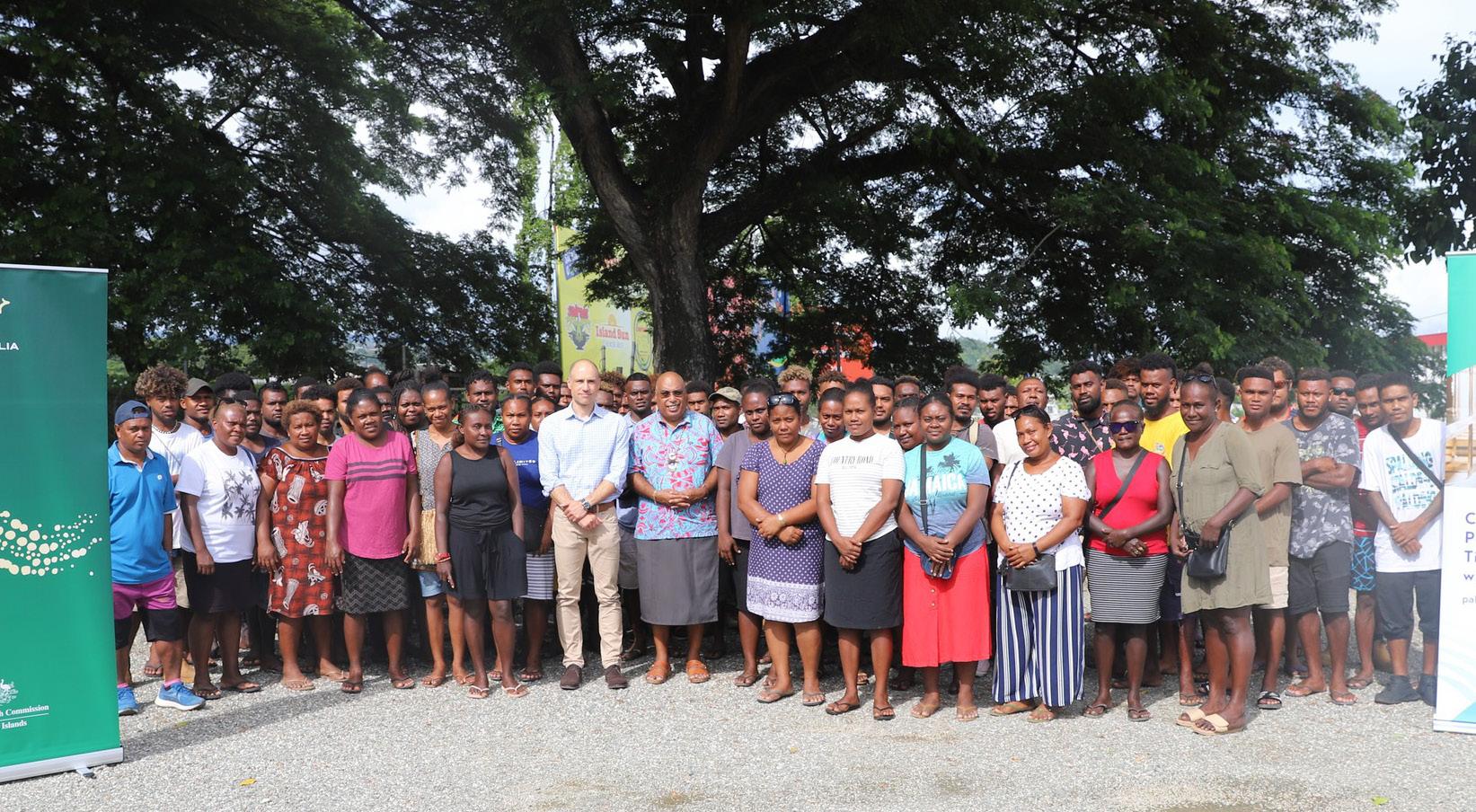
When Labor Mobility Ate the Market FACE PALM:
By DAVID SPRING PT COLUMNIST Sydney, Australia
"WHERE'S A GOOD young bloke when you need 'im?" Tony*, a lettuce grower in Victoria, Australia, needs farm labor. He advertises locally, but no one responds. "Don't need a brain surgeon, just someone reliable and strong!"
He discovered the Pacific Australia Labour Mobility (PALM) scheme, a foreign policy initiative to bring workers from Pacific Island Countries to Australia. He becomes an approved employer, and soon, two young men from Vanuatu arrive –exactly who he was looking for.
But what about the "Tonys" in Vanuatu also seeking workers? Let's explore how this scheme originated and how it both benefits and hinders Pacific Island countries.
Growing PALM Trees
In 2008, Australia adopted a successful New Zealand model –a seasonal worker scheme for fruit pickers and rural workers. Most Pacific Island countries now participate, and PALM currently employs over 37,700 Pacific and Timor-Leste workers (as of 31 March 2023).
Studies show financial benefits for both individuals and
participating economies. Workers report being able to support their children's education, fund home improvements, start businesses, and acquire assets. However, challenges exist. There have been reports of poor treatment by employers, excessive wage deductions, and pressures back home. In response, rules have been adjusted and greater flexibility introduced, such as employer portability, allowing Ni-Vanuatu workers to switch employers if Tony (Australia) proves to be a bad boss. New visa categories enable workers in other sectors to stay for several years, instead of the standard nine months.
While permanent residency isn't an option under PALM, longterm visas (up to four years) are available for specific skills.Other improvements, like allowing workers to bring their families, are under consideration.
Shortage at Home
Despite the financial gains, the schemes create challenges for sending countries, notably a skills shortage. PALM targets low- and medium-skilled workers for regional areas in meat
> www.pacifictenders.com COMMERCE & LABOUR 15
PALM recruits in Solomon Islands after a briefing with representative of the Australian High Commission and the Solomon Islands Government Ministry of Foreign Affairs.
processing, aged care, and hospitality. However, in countries like Vanuatu, where PALM wages can be ten times higher than local wages, the scheme attracts workers of all skill levels,leading to domestic shortages. Vanuatu's "Tony" needs a formwork carpenter for his new building contract but finds no local candidates. He's forced to choose from unskilled or unwilling workers and invest in training.
PALM distorts the labor market and can harm social cohesion due to uneven prosperity among otherwise equal households. By addressing one problem, PALM creates others. Yet, improving economic outcomes in Pacific Island countries and fostering social ties between Australia and its neighbors are core objectives of Australia's aid program. These outcomes alone will ensure PALM's continuation.
The scheme's central tension – the trade-off between the needs of Australian employers and the development of Pacific Island nations – cannot be fully resolved through policy




APRIL - JUNE / ISSUE 16
& LOGISTICS Kukum Highway, Honiara, Solomon Islands www.hatanga.com 30401 contact@hatanga.com
CIVIL, CONSTRUCTION
Two Pacific Islanders hard at work in a farm in Australia, Thanks to the PALM programme which has significantly impacted livelihoods in the region.
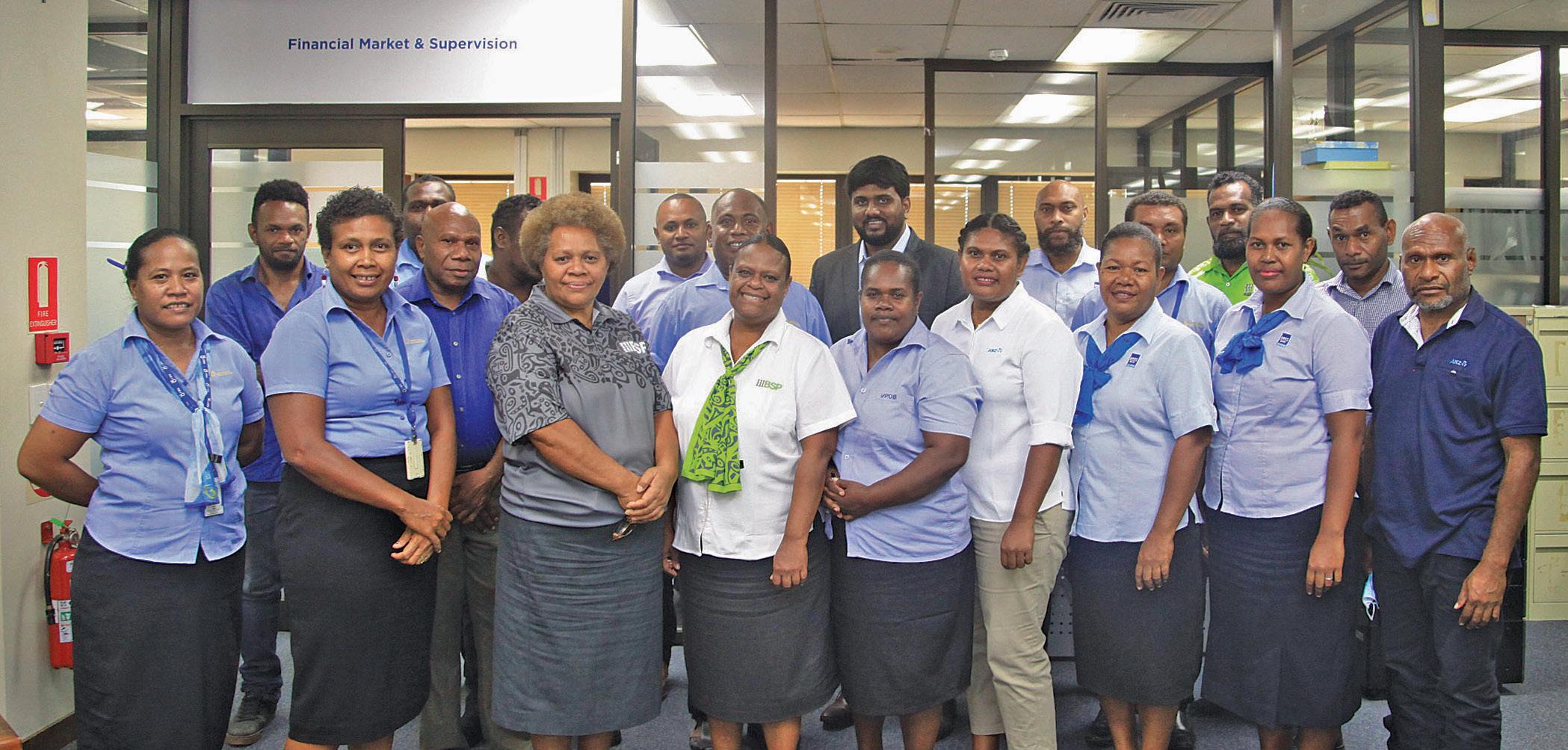
NEW PAYMENT SYSTEM
Solomon Islands’ New Payment System to improve efficiency in payment and Increase
Access to Banking, Support Economy
SOLOMON ISLANDS will benefit from a new financial payment infrastructure that will simplify banking, contribute to the digitalization of the economy, and drive inclusive, sustainable economic development.
Launched on April 8th by the Central Bank of Solomon Islands (CBSI), the new digital payment platform, the Solomons Automated Transfer System (SOLATS), is a real-time gross settlement (RTGS) payment system. It will enhance efficiency and security in the financial system, making it more accessible and convenient for all.
IFC, a member of the World Bank Group, with funding from the governments of Australia and New Zealand, and support from the World Bank, provided technical expertise to the CBSI for these developments. This follows similar transformations undertaken by central banks in Papua New Guinea, Fiji, Samoa, and Vanuatu, all aimed at facilitating responsible and inclusive digital financial services in the Pacific.
This initiative is crucial for driving economic development and financial inclusion in the Pacific Islands nation. According to a 2015 demand-side survey, over 30% of adult Solomon Islanders lack bank accounts and access to banking services, forcing them to rely on cash.
"This new platform revolutionizes payments in Solomon Islands," said Dr. Luke Forau, Governor of CBSI. "Individuals, businesses, and the government will benefit from secure, efficient, and convenient transactions. SOLATS is a significant step towards a more digital economy for Solomon Islands and will create conditions for banks and other financial institutions to offer new services."
SOLATS, overseen by CBSI, will improve security and efficiency in the financial system. It ensures secure transactions, protecting customers and businesses from fraud, and simplifies transactions for purchasing goods or sending money. SOLATS will also facilitate various payment options, including electronic and mobile payments.
This new platform replaces the previous inefficient system of manual interbank transfers that relied on checks, often leading to delays in clearing funds and hindering commerce and economic activity. Over time, SOLATS is expected to help reduce reliance on checks and cash in Solomon Islands.
CBSI will also soon launch a Central Securities Depository (CSD), a financial market platform based on an electronic registry holding all government and central bank securities. The CSD will be linked to SOLATS in real-time, ensuring the safekeeping and accurate recording of securities transactions, increasing efficiency in securities trading, and supporting the development of Solomon Islands' capital markets.
"These important developments in the financial system will help boost financial inclusion and economic activity in Solomon Islands," said Judith Green, IFC Country Manager for Australia, New Zealand, Papua New Guinea, and the Pacific Islands. "Secure and efficient payment systems, along with robust capital markets, are crucial to reducing poverty and boosting prosperity. IFC is working with central banks and other partners across the Pacific to help create this transformative change."
The ongoing reform program, overseen by CBSI, will continue to modernize Solomon Islands' financial sector with the introduction of further regulations.
> www.pacifictenders.com 17
E-COMMERCE
CBSI successfully completed a one-week training session on the ATS solution for its stakeholders (Administration and Operation teams) from the 14th to 18th of November 2022 at the CBSI premises. (Credit CBSI Joint Press release)
Ai IN PACIFIC PROCUREMENT, DESPITE INFRASTRUCTURE GAPS
By LORNA BONDOC
PT Marketing and Research Consultant Manila, Philippines
Across the Asia-Pacific (APAC) region, a paradigm shift is underway within procurement functions. This transformation is driven by Artificial Intelligence (AI), poised to revolutionize the way businesses and governments source goods and services. Far from mere speculation, a recent McKinsey report on AI in Procurement projects AI could generate up to $1 trillion in annual cost savings for procurement globally by 2030. For the Pacific Islands and broader APAC region, this presents an unprecedented opportunity to leapfrog traditional methods and establish themselves as innovation leaders in procurement.
Potential and Challenges
The APAC region is a procurement powerhouse, on track to account for over 50% of global procurement spending by 2025 APAC procurement growth. However, the region also faces challenges like fragmented markets, complex regulatory environments, and limited access to skilled talent. These very issues create a fertile ground for AI to flourish. Additionally, many APAC governments, particularly in the Pacific Islands, grapple with limited infrastructure budgets.
n Automated Repetitive Tasks. Mundane activities such as contract review, invoice processing, and risk management are streamlined, freeing procurement professionals to focus on strategic initiatives like supplier relationship management and category sourcing strategies.
n Improved Supplier Management. AI can scour vast databases to identify and qualify new suppliers, ensuring access to a broader pool of qualified vendors, especially in geographically dispersed regions like the Pacific Islands. This is particularly beneficial for complex projects that require a diverse range of expertise.
n Reduced Procurement Costs. From negotiation support to optimizing sourcing strategies, AI can significantly reduce procurement costs and lead to a more favorable value proposition.
Government Investment is a Catalyst for Transformation
While AI can function even with limitations in physical infrastructure, government investment can significantly accelerate the adoption and impact of AI in procurement across APAC:
n Digital Infrastructure Development. Investment in reliable internet access, cloud computing capabilities, and secure data storage solutions are crucial for seamless AI integration. Partnering with private entities through Public-Private Partnerships (PPPs) can help bridge infrastructure gaps and facilitate faster development.
Asia is on track to top 50 percent of global GDP by 2040 and drive 40 percent of the world’s consumption, representing a real shift in the world’s center of gravity.
AI's Transformative Impact on Procurement, Despite Infrastructure Gaps
AI offers a multifaceted approach to these challenges, empowering procurement teams with the following capabilities:
n Enhanced Data Analytics. Previously unimaginable volumes of data transform into actionable insights, even with potentially limited data infrastructure. AI can identify hidden trends, predict market fluctuations, and optimize supplier selection based on multidimensional criteria encompassing not just cost, but also factors like sustainability and social responsibility.
n Building a Skilled Workforce. Investing in AI skills development programs can create a local talent pool that can design, implement, and maintain AI-powered procurement systems. This fosters innovation and reduces reliance on foreign expertise.
n Standardization and Regulations. Governments can play a key role in establishing clear guidelines and regulations for AI use in procurement. This fosters trust in the technology and protects against potential misuse.
The Pacific Islands: Leading the Charge Despite Infrastructure Constraints?
While resource constraints exist within the Pacific Islands, their agility and openness to new technologies can position them as regional leaders in AI-powered procurement, even with limitations in physical infrastructure:
n Leapfrogging Legacy Systems. Pacific Island nations often lack the burden of outdated procurement infrastructure, allowing them to adopt cutting-edge AI solutions without the need for complex system integrations. This presents a significant advantage over their APAC counterparts saddled with legacy systems.
OPINION PIECE
www.pacifictenders.com < APRIL - JUNE / ISSUE 16 18
n Cloud-Based Solutions. Many AI procurement solutions are cloudbased, requiring minimal physical infrastructure on the user's end. This can be a significant advantage for the Pacific Islands where local infrastructure may be limited.
n Focus on Mobile Solutions. Mobile-based AI solutions can be particularly effective in geographically dispersed regions like the Pacific Islands. Procurement officers can access real-time data and analytics on the go, streamlining processes and improving decisionmaking.
Collaboration is Key
Regional collaboration between Pacific Island nations can leverage combined resources and expertise to develop and implement best practices in AI procurement. Sharing knowledge and best practices fosters a more robust and innovative ecosystem across the region.
On the Road to AI-Powered Procurement
Embracing AI in procurement doesn't require a complete overhaul. Here are some practical steps C-Level executives and procurement leaders across APAC can take:
n Identify Procurement Pain Points. Begin by pinpointing areas where inefficiencies cost time, money, or resources. This will guide your AI implementation strategy. Focus on areas where manual data analysis is time-consuming or error-prone, or where improved supplier discovery and management can lead to significant cost savings.
n Embrace Cloud-Based Solutions. Prioritize cloud-based AI solutions that require minimal on-site infrastructure. This approach mitigates the limitations of existing physical infrastructure in the Pacific Islands and allows for faster and more cost-effective implementation.
n Seek Guidance. Pacific Tenders Magazine can connect you with industry experts who can navigate the ever-evolving world of AI procurement solutions, even with infrastructure limitations. We can also provide insights into successful AI implementations across various industries within the APAC region, showcasing how others have overcome similar challenges.
n Start Small, Scale Gradually. Don't try to execute a complete overhaul. Begin with a pilot project focused on a specific area like invoice processing or supplier risk management, even if the data resides on local servers. Measure your success and scale up based on the positive impact you see.
The Future of Procurement
The future of procurement is one characterized by intelligence, automation, and data-driven insights. As AI continues to evolve, the APAC region has a unique opportunity to become a global leader in this transformative shift. By embracing this technology, fostering a culture of collaboration, and actively seeking solutions that address infrastructure limitations, governments and businesses across APAC can unlock the immense potential of AI procurement and build a more efficient, sustainable, and prosperous future for the region.
This journey requires a collaborative approach. Governments must prioritize digital infrastructure development, workforce training, and clear AI regulations. Businesses, meanwhile, need to embrace agility, explore cloud-based solutions, and start small while aiming for big results. Together, we can transform the procurement landscape within APAC, ensuring the Pacific Islands don't just keep pace, but leapfrog ahead as innovation leaders in the exciting world of AI-powered procurement.

TECHNOLOGY

MAIN WORKS TO COMMENCE AT NAHA BIRTHING AND URBAN HEALTH CENTRE
Construction of the new SBD250m/AUD45m Naha Birthing and Urban Health Centre in East Honiara has officially commenced.

AUSTRALIA’S DEPUTY Prime Minister, the Hon. Richard Marles MP, was joined by Solomon Islands Minister for Health and Medical Services, Hon. Dr Paul Popora Bosawai, at a ceremony at the new Naha Birthing and Urban Health Centre construction site to officially mark the commencement of main works construction.
“Once complete, this centre will see the very best of care be provided to this community and Honiara,” Mr Marles said.
“We want this birthing clinic to make a real difference to the health and lives of the people of Solomon Islands, now and well into the future.
“The facility will be built to Australia’s high standards of quality.
“We’ll include local workers wherever possible, we’ll listen to the voices of the community and health workers who will use this new facility, and we will complete this project together.”
The centre will provide a new benchmark of health care in Solomon Islands.
New mothers and mothers-to-be will be able to access the very best pre and post-natal care, giving the next generation of Solomon Islanders the very best start possible, and easing
pressure on the National Referral Hospital.
The new centre has also been designed to withstand earthquakes and other natural disasters and will be delivered ready to go, with high quality equipment, and staff trained in how to use it.
“Most importantly, Australia will also support the handover and maintenance of the facility to ensure the Ministry has the skills and know-how to maintain it well into the future,” Mr Marles said.
Once complete the centre will provide first class birthing, pre and post-natal care services for women, as well as eye, dental, pathology, x-ray and ultrasound and pharmacy services. A large general-purpose room will provide a flexible space for public and community health initiatives.
Following the ceremony Mr Marles met with Naha Clinic nurses, community representatives and local contractor, Alrico Constructions to thank them for their ongoing commitment to the project.
Construction will commence shortly managed by Australian funded Solomon Islands Infrastructure Program with works expected to take 24 months.
www.pacifictenders.com < 20
Australia’s Deputy Prime Minister, the Hon. Richard Marles MP (centre) with officials from both the Australian and Solomon Islands governments, representatives of the Naha Community, officials from the Solomon Islands Infrastructure Program and the nurses and health workers of Naha Clinic.
ADVERTORIAL



MINISTER BOSAWAI OFFICIATES IN START OF WORK EVENT AT NAHA BIRTHING AND URBAN HEALTH CENTRE
THE MINISTER for Health and Medical Services (MHMS) the Hon. Dr Paul Popora Bosawai, on 21st May, joined the Australian Deputy Prime Minister the Hon. Richard Marles MP at the proposed sbd 250 million Naha Birthing and Urban Health Centre site, for a brief ceremony to officially mark the start of construction work at the site, located at Naha One, next to the existing Naha clinic.
The brief ceremony was attended by officials from both the Australian and Solomon Islands governments, representatives of the Naha Community, officials from the Solomon Islands Infrastructure Program and the nurses and health workers of Naha Clinic.
Speaking at the ceremony MHMS Minister the Hon Dr Bosawai said the establishment of the Birthing Centre commencing construction in July 2024, will be a first for the country and will enable high quality birthing services for new mothers and their babies in a modern, safe environment outside of the National Referral Hospital.
“This Birthing Centre will have capacity for up to 1500 low risk deliveries per year and this will greatly assist with reducing the workload on the NRH Delivery Wards and the NRH’s over-worked midwifery staff.
Minister for Health and Medical Services Dr Bosawai speaking during the event
“The long-awaited project commencement could not have come at a better time given NRH current challenges. Currently, at the NRH, the labour ward attends to 6,177 deliveries in 2023, with an average 5,771 per year 2021 to 2023, which is an estimate of 500 births per month, about 125 births weekly and about 18 births per day. This scenario is such that it puts additional pressure
and has implications on many other things including bed space, workforce, medical supplies and consumables, budget, logistics, and primary care services to name a few.”
“The pressure on beds at the current birthing ward at NRH is always extremely high. There are 10 recovery beds in the labour ward. So, if the labour ward has to have about 18 deliveries per day on average, bed occupancy would of course become a huge challenge. In 2023 the bed occupancy rate is 126%. Given such challenging situations, upon delivery, mothers should stay at least 24 hours at the hospital but given the lack of space, mothers are usually discharged eight hours after giving birth. This is very risky for both mothers and babies as sometimes either the mothers or babies will develop other illnesses while at home. Space limitations at the NRH is a challenge whilst the population growth continues at 2.8 annually,” said Minister Bosawai.
The Health Minister also thanked Australia for their funding support towards the Birthing Centre.
“Allow me to also to take this moment to acknowledge the presence of the Deputy Prime Minister and Minister of Defence of Australia, Honourable Richard Marles. Thank you indeed for gracing us this afternoon and my sincerest appreciation to your Government and the people of Australia for the substantial support of SBD$250 Million towards the construction of this modern facility.”
“It is my hope and wish that the new Naha birthing facility will truly deliver the services it promises. That this new mother who will one day use the upcoming new facility will truly represent her needs, this new mother is not asking for favours, she just wants to give birth safely and that she maintains her dignity,” said Minister Bosawai.
> www.pacifictenders.com 21
(top left) Australia’s Deputy Prime Minister, the Hon. Richard Marles MP meeting Ms. Freda of the local construction company Alrico at the project site. (top right) Australia’s Deputy Prime Minister, the Hon. Richard Marles MP handing over the project documents to the Minister for Health and Medical Services (MHMS) the Hon. Dr Paul Popora Bosawai.
ADVERTORIAL
How Procurement Efficiencies Drive Organizational Excellence
By LORNA BONDOC PT Marketing and Research Consultant Manila, Philippines
COMPETITION AND economic volatility makes organizational efficiency paramount. Procurement, the lifeblood of any organization's resource acquisition, presents a significant opportunity for optimization. This article explores the concept of procurement efficiency, its far-reaching impact across various industries, and the strategic implementation of best practices and technology to unlock its full potential.
The Efficiency Imperative in Procurement
Procurement efficiency entails streamlining the process of acquiring goods and services, encompassing everything from needs identification and vendor sourcing to contract negotiation and delivery management. This strategic approach fosters significant improvements in several critical areas:
n Cost Reduction: Streamlined workflows minimize administrative overhead, while robust negotiation strategies secure optimal pricing. But efficiency goes beyond just the bottom line. It frees up procurement teams to focus on strategic initiatives, such as supplier relationship management and category management, that can unlock even greater cost savings and value creation.
n Enhanced Visibility: Real-time data provides granular insights into spending patterns, enabling informed decisionmaking and effective budget control. Procurement efficiency isn't just about cost reduction, it's about spend optimization. By leveraging spend analytics, organizations can identify areas for consolidation, negotiate volume discounts, and eliminate maverick spending, ensuring every dollar spent delivers maximum value.
n Risk Mitigation: Standardized procedures and comprehensive vendor vetting minimize procurement risks and ensure regulatory compliance. A robust and efficient procurement process reduces the risk of errors, delays, and fraud. It ensures compliance with regulations, minimizes legal exposure, and safeguards the organization's reputation.
n Accelerated Cycle Times: Automation of workflows and adoption of e-procurement platforms expedite the entire procurement process. Efficiency isn't just about saving money, it's about saving time. By automating repetitive tasks and leveraging e-procurement tools, organizations can significantly reduce procurement cycle times, ensuring critical resources are delivered when needed to keep projects and operations on track.
n Strengthened Collaboration: Improved communication across departments fosters stronger relationships with vendors and internal stakeholders. A truly efficient procurement function fosters a collaborative environment. Procurement teams can work more effectively with internal stakeholders to understand their needs, while also building
Streamlined government
procurement ensures optimal utilization of taxpayer dollars, leading to enhanced public services and infrastructure development. In today's fiscally constrained environment, efficient procurement is essential for governments to deliver essential services to citizens while staying within budget.
strong relationships with vendors to ensure they deliver the quality, value, and innovation the organization requires.
Industry-Specific Impact
The benefits of procurement efficiency transcend sectoral boundaries, generating tangible value across various industries:
n Public Sector: Streamlined government procurement ensures optimal utilization of taxpayer dollars, leading to enhanced public services and infrastructure development. In today's fiscally constrained environment, efficient procurement is essential for governments to deliver essential services to citizens while staying within budget.
n Healthcare: Efficient acquisition of medical supplies and equipment translates to cost savings that can be directly channeled towards improved patient care. A streamlined procurement process in healthcare allows hospitals and clinics to focus on their core mission of delivering quality care, while also ensuring they have the necessary supplies and equipment to do so effectively.
n Construction: Optimized procurement of materials and services facilitates adherence to budgets and project timelines. In the fast-paced construction industry, even minor delays can have a significant impact on costs. Efficient procurement ensures projects have the materials they need, when they need them, to stay on schedule and within budget.
n Engineering: Strategic sourcing and negotiation of specialized equipment enables cost savings that can be reinvested in critical research and development initiatives.
www.pacifictenders.com < APRIL - JUNE / ISSUE 16 22
For engineering firms, efficient procurement ensures they have access to the cutting-edge tools and technologies they need to drive innovation, while also controlling costs.
n Education: Efficient procurement of educational materials and technology frees up resources for the creation of more effective learning environments. In the education sector, efficient procurement allows schools to focus on providing students with the resources they need to succeed, while also ensuring responsible use of taxpayer dollars.
n IT Services: Streamlined procurement of software and hardware fosters faster implementation and cost optimization within IT infrastructure. In the ever-evolving IT landscape, efficient procurement allows organizations to quickly acquire the technology they need to stay competitive, while also ensuring they are getting the best value for their investment.
The Technological Imperative
Technology serves as a key catalyst for driving procurement efficiency. Cloud-based procurement software empowers organizations to automate repetitive tasks, facilitate data analysis, and streamline collaboration with internal and external stakeholders. Features like e-sourcing, e-invoicing, and spend analytics empower informed decision-making and cost optimization strategies.
Building a Culture of Procurement Efficiency
The successful implementation of a strategic procurement program necessitates a multi-faceted approach:
n Executive Sponsorship: Securing leadership buy-in is crucial
for establishing a culture of efficiency and acquiring necessary resources. Without strong leadership support, procurement initiatives can struggle to gain traction. Executive sponsorship sends a clear message that procurement is a strategic function and empowers procurement teams to make the necessary changes.
n Standardized Processes: Implementing clear guidelines and best practices for needs identification, vendor selection, and contract management ensures consistency and minimizes errors.
n Data-Driven Decision Making: Leveraging robust data analytics empowers procurement teams to identify spending patterns, negotiate effectively, and make informed sourcing decisions.
n Supplier Relationship Management: Fostering strategic partnerships with key suppliers leads to better pricing,improved quality, and greater innovation.
n Continuous Improvement: Building a culture of continuous improvement encourages ongoing process evaluation,refinement, and the adoption of new technologies to maintain optimal efficiency.
Procurement efficiency is more than just a cost-cutting exercise; it's a strategic approach that fuels organizational excellence. Organizations can strike significant cost savings, enhance visibility, mitigate risks, accelerate cycle times, and strengthen collaboration. Efficient procurement is no longer a competitive advantage, it's a necessity. Best practices, technology, and a culture of continuous improvement, are pillars that support various procurement functions to become a powerful engine for growth and success.

PROCUREMENT


PT your next project here www.pacifictenders.com FIND
COMPREHENSIVE PROJECT MANAGEMENT CRUCIAL FOR LARGE-SCALE CONTRACTS:
The Naha Birthing and Urban Health Centre Case
By DOUGLAS SAEFOA PT EDITOR Honiara, Solomon Islands
THE LONG-AWAITED construction of the Naha Birthing and Urban Health Centre in East Honiara has been relaunched after a five-year hiatus. The project, now valued at SBD 250 million (AUD 45 million), originally started in 2019 but faced significant setbacks due to insufficient site investigation and the need for a comprehensive Geotech survey. These issues necessitated a redesign and the subsequent halt of the project in 2021.
Initially funded at $25 million, the project aimed to address urgent healthcare needs in Honiara. However, construction was stalled after initial assessments revealed foundational challenges. A Geotech study indicated the necessity for a new design to ensure the building's stability, leading to the project's suspension before moving into its second phase.
In October 2022, a new design was confirmed through collaboration between the Australian and Solomon Islands governments. The Solomon Islands Infrastructure Program (SIIP) was appointed to oversee full project management, initiating a fresh tender process. A groundbreaking ceremony in January 2023 marked the renewed commitment to the project, and later that year, local contractor Alrico Construction was tasked with earthworks and site preparation.
On May 22, 2024, Australia's Deputy Prime Minister, Hon. Richard Marles MP, and Solomon Islands Minister for Health and Medical Services, Hon. Dr. Paul Popora Bosawai, officiated a ceremony at the construction site to celebrate the commencement of the main works. The Deputy Prime Minister announced that Reeves Icon Partnership would undertake the construction.
“Once complete, this centre will see the very best of care provided to this community and Honiara,” Mr. Marles stated.
“We want this birthing clinic to make a real difference to the health and lives of the people of Solomon Islands, now and well into the future. The facility will be built to Australia’s high standards of quality. We’ll include local workers wherever possible; we’ll listen to the voices of the community and health workers who will use this new facility, and we will complete this project together.”
The new centre promises to set a new benchmark for healthcare in the Solomon Islands. It will offer comprehensive pre and postnatal care, easing the burden on the National Referral Hospital. Designed to withstand earthquakes and other natural disasters, the facility will be equipped with high-quality equipment and staffed by trained professionals.
Australia has also committed to supporting the handover and ongoing maintenance of the facility to ensure its longevity and efficacy. Once completed, the centre will provide a wide range of services, including birthing, eye care, dental, pathology, x-ray, ultrasound, and pharmacy services. Additionally, a large

general-purpose room will serve various public and community health initiatives.
Following the ceremony, Mr. Marles met with Naha Clinic nurses, community representatives, and local contractor Alrico Constructions to express gratitude for their dedication to the project. The construction, managed by the Australian-funded SIIP, is expected to take 24 months.
Delivering projects in the Pacific Islands presents unique challenges. The Naha Birthing and Urban Health Centre project exemplifies the complexities of large-scale donor-funded initiatives. Initially estimated at AUD 25 million, the project faced hurdles such as poor site investigation, non-compliant designs, procurement issues, contract disputes, and ineffective consultation. This relaunch underscores the necessity for experienced, technically competent, and contextually informed consultants at every project stage to ensure successful delivery. The Naha Birthing and Urban Health Centre aims to provide first-class healthcare services and significantly improve the health and well-being of the Honiara community and beyond.
INFRASTRUCTURE DEVELOPMENT / INDUSTRY > www.pacifictenders.com 25
Australia’s Deputy Prime Minister, the Hon. Richard Marles and Health Minister Dr. Paul Popora Bosawai being led to the Naha Birthing project site.

PNG Prime Minister James Marape (centre) with Country Director of the ADB
and government officials and representatives of ADB.
PNG,
ADB Finances K7.8 million Airport Project in Milne Bay
THE GROUNDBREAKING ceremony for the Gurney Airport Upgrade in Milne Bay Province marked a significant milestone for Papua New Guinea’s aviation sector. Attended by the Country Director of the Asian Development Bank (ADB) in Papua New Guinea, Mr. Said Zaidansyah, and officiated by Prime Minister James Marape on Friday, May 10, 2024, the event signified the commencement of the ADB’s flagship project in the country, the Civil Aviation Development Investment Program Phase 2 (CADIP 2).
Gurney Airport, the first of five airports slated for improvement under CADIP 2, is poised to undergo extensive enhancements. These upgrades are part of a broader effort to bolster air transport infrastructure across the nation. The CADIP 2 initiative encompasses not only airport upgrades but also improvements to power supply at Port Moresby airport, the construction of an Air Traffic Control Tower at Goroka Airport, and the enhancement of four rural airstrips to all-weather standards. Prime Minister Marape emphasized the strategic importance of the Gurney Airport Terminal and associated works, which aim to facilitate international flights and reignite Milne Bay’s potential as a premier tourist destination within Papua New Guinea. Speaking at the launch of the K76.8 million upgrade works, Marape underscored Milne Bay’s rich tourism offerings and highlighted the airport’s pivotal role in elevating the province’s profile.
The upgrade works at Gurney Airport, awarded to the China Railway Construction Engineering Group Co. Ltd, will encompass various enhancements. These include the asphalt surfacing of existing and new aircraft pavements, the expansion of the apron to accommodate a range of aircraft, and the construction of a modern Terminal Building equipped with advanced passenger and cargo facilities. Additionally, a new airfield lighting system will enable night operations, enhancing the airport’s functionality and safety.

The commencement of the Gurney Airport upgrade project marks the inaugural phase of CADIP 2, a collaborative endeavor between the National Airports Corporation (NAC) and the Asian Development Bank. The project’s scope extends beyond infrastructure upgrades, with the signing of memoranda of agreement between NAC, the Milne Bay Provincial Government, and the PNG Fire Service further underscoring the commitment to airport safety and compliance.
With project commencement slated for the upcoming week, stakeholders anticipate the timely delivery of upgraded facilities to the people of Milne Bay within the next two years. The CADIP 2 initiative aligns with the government’s broader agenda to enhance connectivity and foster sustainable development across Papua New Guinea, reflecting a concerted effort to advance the nation’s aviation sector and bolster economic growth. - PT MEDIA
in
Mr. Said Zaidansyah (second from right)
www.pacifictenders.com < APRIL - JUNE / ISSUE 16 26
Groundbreaking ceremony at the construction site.
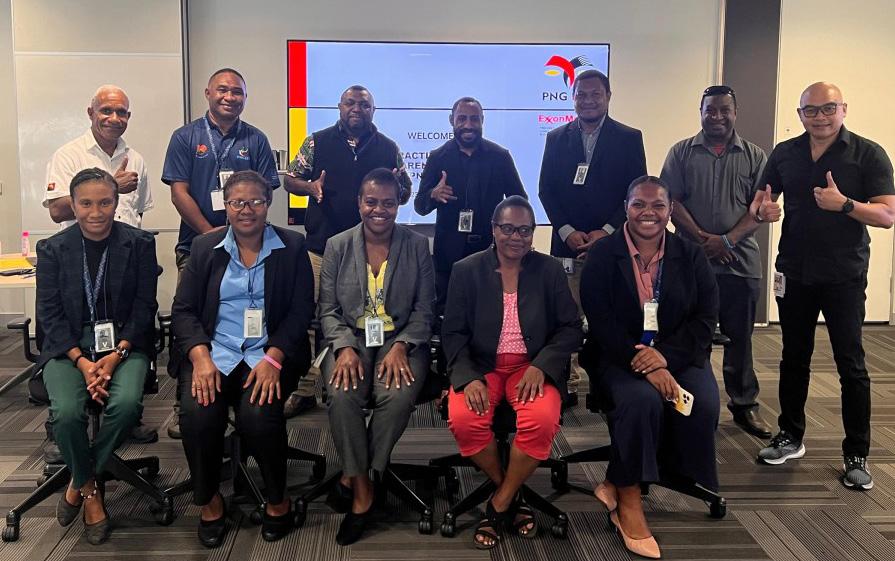
Ensuring Fairness and Transparency in Extractive Projects
By JASON PAISOI PT Contributing Writer
Moresby, PNG
ON MAY 23, PNGEITI staff attended a comprehensive oneday session in Port Moresby conducted by Exxon Mobil's government relations team, which focused on the impacts of the PNG LNG project.
The gathering, organized by the PNG Extractive Industries Transparency Initiative (PNGEITI), served as a platform for dialogue and reflection on the equitable distribution of benefits from extractive projects.
The workshop delved into various subjects, encompassing updates on the PNG LNG Project, revenue allocation to the State, the Infrastructure Tax Credit scheme, National Content initiatives focusing on workforce and supplier development, and corporate social responsibility endeavors in community investment.
Jonathan Omae, serving as the workshop's facilitator, meticulously specify the direct and indirect benefits stemming from the LNG project. From tangible economic dividends to intangible social opportunities, Omae painted a compelling picture of the project's transformative potential. However, amidst the optimism, concerns emerged regarding the equitable distribution of benefits to local communities. Questions surfaced regarding the transparency and efficacy of the revenue distribution process, particularly at the provincial
level.
PNGEITI's Projects and Procurement Director, Diclah Taureka, voiced apprehensions about the accountability of these mechanisms and the adequacy of benefits reaching impacted communities. In response, assurances were provided regarding the existence of a fair framework, albeit with lingering doubts about its practical implementation.
As the workshop drew to a close, participants echoed a resounding call for fairness and transparency in the distribution of project benefits. The imperative of ensuring that revenues from extractive projects, such as the PNG LNG, are equitably allocated to benefit all stakeholders, especially communities directly impacted by the project, was underscored. This resonated with the overarching mission of PNGEITI – to promote accountability and foster public trust in the management of natural resources.
The task ahead rests with industry stakeholders and affected communities to push for change, ensuring that revenue from not just the PNGLNG Project but also other extractive ventures are distributed equitably and openly, benefiting all stakeholders, especially the communities directly affected by these projects in the provinces.
ExxonMobil Government Relations team with the PNGEITI team, after the workshop at ExxonMobil HQ, 7mile, Port Moresby.
INFRASTRUCTURE DEVELOPMENT / INDUSTRY > www.pacifictenders.com 27
Port
SINPF $81 MILLION DOLLAR INVESTMENT
SINPF Board Deputy Chairman (Centre) together with the contractor and project team at the groundbreaking
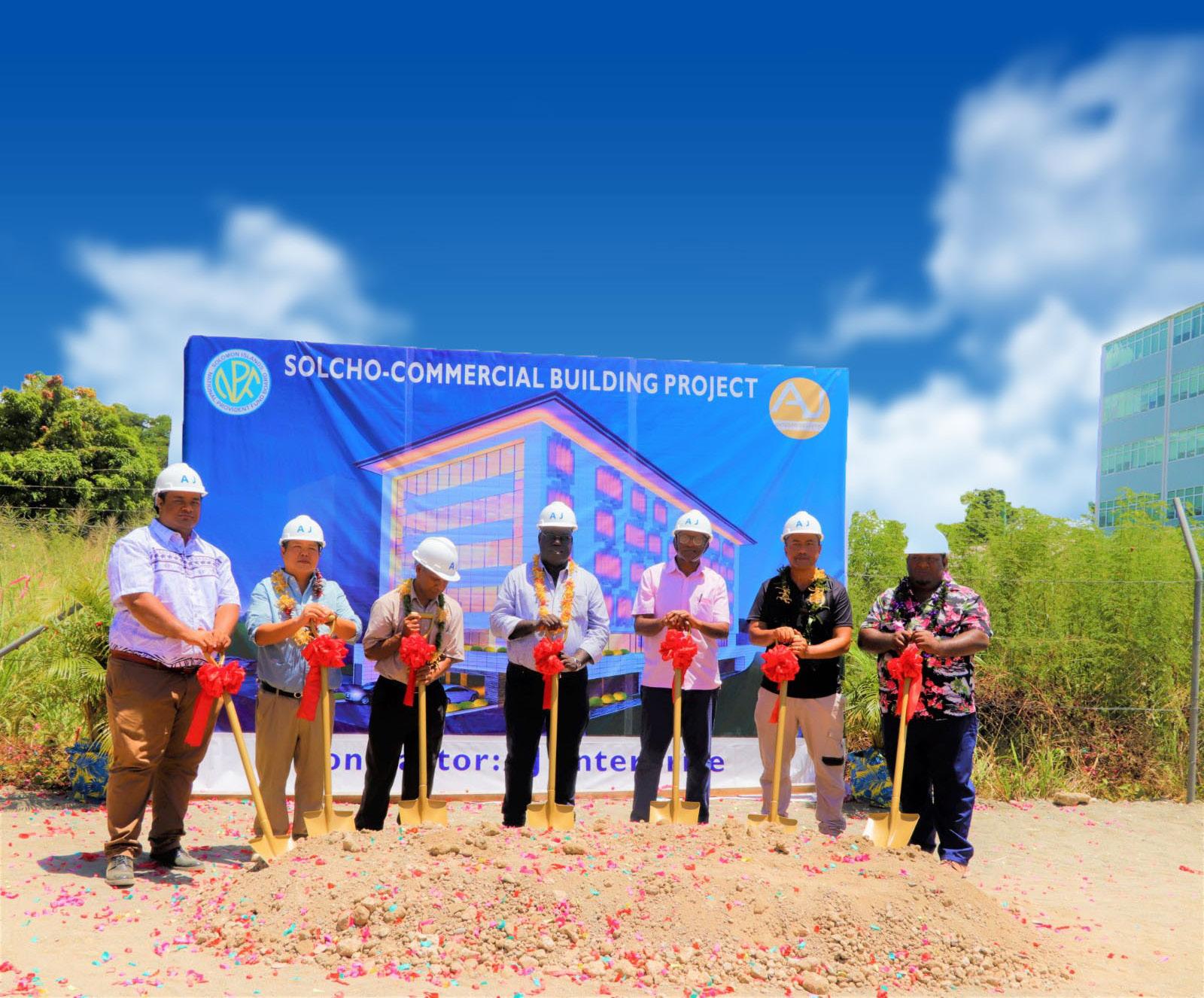
SINPF $81 Million Dollar Project for New Commercial Building Commences
THE SOLOMON Islands National Provident held a groundbreaking ceremony on the 29th March 2024 to commence the construction of the new SINPF commercial building opposite the new Ombudsman Office in Honiara.
Speaking at the ceremony the Deputy Chairman of SINPF Board
David Rupokets said this new commercial property located in the heart of the Honiara CBD is expected to cost around SBD81 million (inclusive of all taxes) and construction is expected to take up to 20 months to complete.
“Today, we are marking the beginning of construction works of this new commercial property by successful bidder AJ Enterprises Limited who successfully tendered for the project among other competitive bidders.
This new property investment will see the development of a basement parking level, a podium level and four (4) levels of Commercial Office spaces with all utilities and services to inclusively serve the needs of all tenants of the building. The Board has already commenced seeking and canvassing for potential tenants for the new commercial property.
For a bit of history, this location where we are now has a long rich history as it was formerly owned and hosted the former iconic government’s owned Solomon Islands Housing Authority Head Office. This asset is part of the sales and purchase agreement settled between the Solomon Islands Government and the SINPF Board when the SINPF Board bought the entity in 2009.
Director Rupokets said the investment journey to develop
this commercial site commenced in 2017 with the Board’s endorsement and Minister of Finance approvals secured in 2018.
However, the project was put on hold when the Board won the public tender to construct a residential accommodation unit for the Commonwealth Government of Australia at the Hibiscus Apartment grounds.
“Today’s ground- breaking is a major milestone in the progress of SINPF Board’s investments in our domestic property investment market”, Director Rupokets said.
With the advance progress of the apartments’ construction (with the 1st phase of the Hibiscus development expected to be completed in December 2024), the Board is now in a position to commence the construction of this new modern 4 level commercial building.
He highlighted that to protect and grow our members contribution balances with good returns, there are also the wider positive ramifications that comes with such new investments that our wider economy will benefit from. These include the creation of new employment opportunities, creating additional business for local suppliers of goods and services and creating additional taxes for the government to pay for its services for our growing population. The completion of this new building will also provide a face lift for our national capital city Honiara. It is expected the commercial building to be handed over to the SINPF Board by AJ Enterprises Limited in November 2025.
www.pacifictenders.com < APRIL - JUNE / ISSUE 16 28
event in Honiara.

NISIT FORGE STRATEGIC PARTNERSHIP FOR TECHNOLOGICAL ADVANCEMENT
By JASON PAISOI PT Contributing Writer
Port Moresby, PNG
IN A SIGNIFICANT move towards global collaboration in science and technology, the Papua New Guinea National Institute of Standards and Industrial Technology (NISIT) and Malaysia's Standards and Industrial Research Institute (SIRIM) have formed a partnership.
Signed on 29 February 2024 at Shah Alam in Malaysia, this agreement marks the start of a promising alliance aimed at driving progress in both countries.
Imagine a transformative partnership igniting industries in PNG! SIRIM's President and Group CEO, Dr. Ahmad Sabirin Arshad, revealed that this collaboration is set to revolutionize standardization and industrial activities in PNG. With SIRIM's diverse range of services including testing, education, and medical aid, the stage is set for unprecedented growth and innovation in the region.
"This cooperation will inadvertently safeguard PNG against unsafe subpar products, promote measurement and technical standards for commerce and industry in PNG, and improve the country’s industrial efficiency," he said.
NISIT's Acting Director-General Mr. Victor Gabi led the NISIT team to Malaysia, accompanied by Executive Managers Mr. Noah Sapak and Mr. Benjamin Zairo, along with additional support staff.
Mr. Gabi expressed: "Our country needs to grow the industry because many businesses in PNG do not have a proper sight to do cross-checking and balancing, and we hope the MOU can help to enhance industrial development to a higher level."
The Commerce and Industry Secretary, Mr David Ganai emphasized the importance of this significant international agreement, stating that it will greatly benefit the country, particularly in the realm of commerce and industry. He emphasized that with NISIT serving as the government's
implementation arm, this deal would undoubtedly enhance commerce and industry.
The agreement aims to foster collaboration between the two parties across various domains, including natural science, engineering and technology, medical and health science, agricultural science, social sciences and humanities, promoting technology transfer and commercialization, and other research areas as mutually agreed by the Parties.
The partnership will function as a platform for collaboration between NISIT and SIRIM, aimed at fostering a strategic alliance to undertake joint technical setups and research and development projects, facilitate the exchange of researchers, scientists, engineers, technical experts, and consultants, organize and participate in scientific meetings, share meteorological, scientific, and technical research findings, collaborate in the joint use of research and development facilities and equipment, co-author publications, foster cooperation in technology transfer, and engage in other mutually agreed-upon activities as documented by both parties.
This partnership seeks to harness collective expertise and resources to address challenges, drive innovation, and advance knowledge in diverse fields of inquiry.
Since 2017, the partnership between NISIT and SIRIM has been thriving. Although the agreement was originally scheduled for signing last year, it encountered challenges. However, SIRIM has assumed responsibility by hosting the event this year instead.
The team from PNG NISIT, Department of Commerce and Industry with the team from SIRIM during the signing of the MoU at its headquarters in Shah Alam in the Malaysia on 29 February 2024. Pic by NISIT media.
INFRASTRUCTURE DEVELOPMENT / INDUSTRY > www.pacifictenders.com 29

MEET OUR SUPPLIERS
KAHUTO
"Connect the Physical & Digital World."
Managing Director Gibson Satu
Our Focus
n Infrastructure
n Forestry
n Mining
n Sub Sea
n Utilities and Resources
n Environment
What We Do

Contact
E: survey@kahutopacific.com
W: www.kahutopacific.com
P: (+677) 25555
M: (+677) 7470280
Office Location: Panatina, Maromaro, Honiara, Solomon Islands
Kahuto delivers a safer and more efficient way of capturing data for surveys, assessments, and inspections by using the latest remote sensing and drone technology. We specialize in Aerial LiDAR Surveys, helping you understand site conditions better than ever before. Whether you need an accurate terrain model of your site or comprehensive data to plan, design, and execute your projects, Kahuto captures the necessary information so you can act on data, not assumptions.
Our Motto: Act on Data, Not Assumptions
We provide the tools to make proactive, data-led decisions, minimizing risks associated with outdated and inaccurate data. Our services enable proactive planning, understanding potential risks, and optimizing project management.
Our Services
n Aerial Survey
n Drone Services:
l Airborne LiDAR
l Terrestrial Scanning
l Echo Sounding
l Ground Penetrating Radar
l Photogrammetry
Why Choose Kahuto
n Poor Data = Poor Design: In the Pacific Islands, there’s a lack of quality public data. Much of the available data is outdated. Stay on top of your project pipeline with informed and accurate real-world data.
n Minimize Risk: Knowledge ensures safety. Get a full picture of the real-world environment into the hands of your contractors and consultants, enabling more informed decisions.
n Save Time: Reduce field time for surveyors with our locally based professionals. Partnered with registered surveyors, we ensure accurate and timely ground control surveys. What traditionally takes months can be captured and delivered by our teams in days.

www.pacifictenders.com < APRIL - JUNE / ISSUE 16 30
GCP
“We are inspired to influence the way the world is built.”
Overview: GCP is a global leader in providing innovative construction products, specializing in waterproofing, fireproofing, and resin flooring solutions.
As of late 2022, GCP is a part of Saint-Gobain, a renowned multinational French group, enhancing its global reach and resources.
Key Offerings:
n Actively pursuing contract opportunities in the Pacific region.
n Expertise in high-performance construction products and technologies.
n Specialize in advanced waterproofing and fire protection solutions.
n Focus on infrastructure, commercial projects, and sustainable construction.
n Aim to collaborate with local authorities and industry partners.
n Enhance the durability, safety, and sustainability of regional buildings and infrastructure.
Notable Projects: GCP’s cutting-edge solutions have been integral in constructing some of the world’s most iconic structures, including:
n Victoria Arts Centre in Melbourne, Australia.
n Petronas Twin Towers in Kuala Lumpur, Malaysia
At GCP our slogan, “We are inspired to influence the way the world is built” reflects our dedication to supporting construction professionals with high-performance materials
Quality Solutions Pacific
“Helping Pacific Island businesses meet International Standards.”

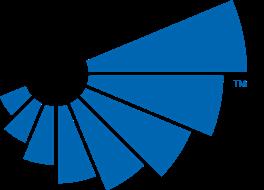

and technologies. For many years, we have enhanced the durability, and sustainability of projects, offering solutions from fireproofing to advanced waterproofing systems. Our expert technical services ensure that our clients’ visions become lasting legacies, providing support at every phase of a project.
At GCP, now proudly part of Saint-Gobain, we are sharing the same vision with their slogan being “Making the world a better home”, and it’s also what we aspire to do every day.
Why Subscribe to Pacific Tenders:
“With the expansion of our resources, we are excited to take the next step in broadening our market presence and deepening our engagement with the Pacific Islands. Pacific Tenders has proven to be the ideal partner for this venture, and we are thrilled to embark on this new journey together!”
Contact
Todd Laidlaw
National Sales Manager Oceania
GCP Pacific Island Contact: +61 401 006 871
Email: todd.laidlaw@gcpat.com
 Dion Palu Managing Director Quality Solutions Pacific
Dion Palu Managing Director Quality Solutions Pacific
Quality Solutions Pacific specializes in preparing and developing management systems for clients to obtain certification to international standards. The primary focus is on ISO, Food Safety, and Organic Standards, enabling businesses to enter new markets and win more tenders.
Quality Solutions is ISO9001 certified as a consulting firm.
Services Offered:
n Certification consulting in ISO9001/45001/14001
n Food Safety certification preparation
n Organic consulting in USDA NOP
n Management systems development
Contract Opportunities:
Quality Solutions Pacific is actively seeking consulting contracts with Pacific Island companies and businesses to help them gain certification, thereby scaling their operations.
Company Slogan/Motto:
“Helping Pacific Island businesses meet International
Standards.” This reflects their role as an “enabler” for trade, resulting in increased sales and exports for their clients through effective certification consulting services.
Reason for Subscription to Pacific Tenders:
Quality Solutions Pacific subscribes to Pacific Tenders to support more local suppliers within the Pacific Islands and help them win more tenders.
Contact Information:
E: info@qualitysolutionspacific.com
P: +(678) 731 2680 / (+678) 22 325 W: www.qualitysolutionspacific.com
Location:
Vila Picardie Building, Numbatu, Efate, Port Vila, Vanuatu
> www.pacifictenders.com 31
Horizon Concepts Ltd
Mike Wood Managing Director of Ultimate Water New Zealand Ltd Horizon Concepts Ltd
1 Ultimate Water New Zealand Limited
n Tenure: December 2017 - Present (6 years 6 months)
n Location: Riverhead, Auckland, New Zealand
n Company Overview: Ultimate Water New Zealand Limited (UWNZ LTD) is located in Riverhead, West Auckland, and is known for its high-quality drinking water. The company extracts 100% natural high alkaline mineral water from beneath their property. Post-COVID, in late 2020, UWNZ LTD began producing boxed and canned mineral water at the source, with the capability to distribute bulk water both locally and internationally.
n Specialty: Superior Quality Drinking Water, 100% Natural High Alkaline Mineral Water.
n Future Plans: Expand production and distribution of boxed and canned mineral water.
Profile Summary:

2 Horizon Concepts Limited
n Tenure: June 2013 - Present (11 years)
n Location: Kumeu, Auckland, New Zealand
n Company Overview: Horizon Concepts Limited is a company with deep roots in the printing industry, now focusing on providing educational services and printing in the Pacific region. The company is committed to quality and reliable service.
n Specialty: Printing and Education Services.
n Future Plans: Post-COVID 2020, the company aims to support Tongan horticulture and seafood producers by assisting in the export of produce such as flowers, kava, root crops, fish, and lobster, in collaboration with Horizon Group Ltd in the Kingdom of Tonga. www.horizonconcepts.co.nz
Mike Wood is an experienced Managing Director with over a decade of leadership in diverse industries. At Ultimate Water New Zealand Limited, he has been at the forefront of providing high-quality natural alkaline mineral water, with innovative packaging and distribution solutions emerging post-COVID. Concurrently, at Horizon Concepts Limited, Mike leverages his extensive printing industry experience to enhance educational services and support the export of Tongan horticultural and seafood products. His strategic vision and commitment to quality and service have positioned both companies for sustained growth and success.


AIFFP LAUNCHES BOAT HARBOUR UPGRADES IN TUVALU
THE AUSTRALIAN Infrastructure Financing Facility for the Pacific (AIFFP) has begun disbursing grant funds for the upgrade of two critical boat harbours on the outer islands of Nui and Niutao in Tuvalu. This initial disbursement of USD 7 million,part of a larger USD 21.4 million commitment, is a collaborative effort between the AIFFP, the Asian Development Bank (ADB), and the Government of Tuvalu, aimed at improving maritime infrastructure throughout the region.
The "Enhancing Boat Harbours Across Tuvalu" project, funded by AIFFP and announced in August 2023 during a visit by Minister for International Development and the Pacific, the Hon Pat Conroy MP, highlights the vital role maritime transport plays in Tuvalu's economy. The project focuses on improving existing and constructing new harbour facilities on Nui and Niutao, thereby enhancing connectivity for passengers and cargo traveling between these islands and Tuvalu's capital.
The project is particularly significant given the reliance of many Tuvaluan island communities on shipping for food and essential services. By improving the availability and reliability of transport options, especially for remote communities,the project will enhance access to markets, services, schools, and healthcare facilities.
Construction and operation of the new harbours are anticipated to generate employment opportunities and income through the sale of goods and services. The project also aims to promote gender inclusivity and economic empowerment, with a target of at least 10 percent female participation in construction roles. Recognizing Tuvalu's vulnerability to climate change, the project
incorporates design and construction measures for mitigation and adaptation, ensuring the resilience of the harbour infrastructure against rising sea levels, cyclones, coastal erosion, and changes in longshore sand movement.
Tuvalu's New Government and Regional Dynamics
Meanwhile, Tuvalu's newly elected government, led by Prime Minister Feleti Teo, has reaffirmed its diplomatic ties with Taiwan despite pressure from China. The government also plans to review a defense and migration agreement with Australia. The government's priorities include strengthening the relationship with Taiwan while seeking improvements to the bilateral agreement with Australia.
Concerns about sovereignty and transparency have been raised regarding the existing pact with Australia, which offers Tuvaluans refuge from climate change threats. The treaty provides assistance during natural disasters and pandemics but also grants Australia veto power, reflecting regional power imbalances. The proactive engagement of the United States and Australia with Pacific nations seeks to counter China's growing influence, as seen in its security pact with the Solomon Islands.

INFRASTRUCTURE DEVELOPMENT / INDUSTRY > www.pacifictenders.com 33

AIFP financed Fiji Road works providing improved market access for local Fijian women vendors.
Australia's AUD 72 Million Investment Transforms Roads, Boosts Markets for Local Women
A TRANSFORMATIVE collaboration between Australia and the Fiji Roads Authority (FRA) is not only reshaping Fiji's transportation landscape but also providing improved market access for local Fijian women vendors.
The Australian Infrastructure Financing Facility for the Pacific (AIFFP), a four-billion-dollar program under the Department of Foreign Affairs and Trade, partners with governments and the private sector in the Pacific and Timor-Leste to provide grant and loan financing for high-quality, transformational infrastructure projects. One such project is the "Restoring Roads and Bridges Across Fiji'' initiative.
The AIFFP, in partnership with the Fiji Government, has provided an AUD 72 million concessional, results-based financing package to support the island nation in repairing and upgrading its roads and bridges. This package includes an AUD 14.7 million grant. The project is designed to bolster Fiji's postpandemic economic recovery while enhancing its resilience to climate change.
The project encompasses the renewal or resealing of over 1.5 million square meters of road surface and the replacement of nine critical bridges with a design life of up to 100 years and the ability to withstand a one-in-100-year rainfall event.This targeted infrastructure investment is a cornerstone of Fiji's efforts to promote economic growth and ensure safe,reliable transportation networks.
In addition to major economic disruption due to the COVID-19 pandemic, Fiji has endured three cyclones in the past two years, causing hundreds of millions of dollars in damage to infrastructure and livelihoods. Climate-resilient infrastructure will help ensure transport networks remain connected, improve safety, and mitigate increased travel time and costs. Beyond concrete and steel, this project fosters economic
empowerment by creating local jobs and integrating climate data for ongoing resilience. The project promises safer roads, reduced travel costs, and increased economic activity. It also improves access to nearby markets for women vendors in these communities, enabling them to sell their produce and support their families.
Community Impact
Salaseini Seruvatu, a 46-year-old resident of Kasavu, Naitasiri Province, now benefits from improved transport and market access due to the upgrade of the Wainawi bridge. She shares her experience:
"The old bridge was in poor condition... We had to cross it to get to the shop... It was a risk... Now, thanks to the bridge upgrade, we get the best of both worlds—good for business and, more importantly, our safety and security."
Ana Ledua, another Kasavu resident and mussel seller, echoes this sentiment. The bridge upgrade has significantly boosted her income, allowing her to provide a better life for her family.
The project's road renewal contractors are all locally registered and employ mostly local Fijian workers. They support the renewal or resealing of road surfaces throughout the country and the replacement of critical bridges, ensuring the road network remains connected and promoting economic activity and access to socio-economic opportunities for local communities.
The AIFFP is proud to contribute to the restoration of Fiji's roads and bridges, fostering economic growth, job creation,and improved market access for local vendors, especially empowering Fijian women. The project is on track for completion in January 2025.
www.pacifictenders.com < APRIL - JUNE / ISSUE 16 34
2024 PNG Resources Week to Unite Stakeholders for Sustainable Growth
By JASON PAISOI PT Contributing Writer Port Moresby, PNG
THE PNG Chamber of Resource and Energy is excited to announce the 2024 PNG Resources Week, set to take place from July 1 to 4 at the University of Papua New Guinea in Port Moresby.
This significant event aims to bring together all stakeholders in the country’s resource and energy sectors under the theme: "Building on Our Legacy: PNG Resources and Energy."
The theme, "Building on Our Legacy: PNG Resources and Energy," is a tribute to the contributions of landowner companies and various groups in the development of the resource sector. It emphasizes the creation of a shared value culture among all stakeholders, ensuring sustainable and equitable benefits from resource development.
The Resource Week will feature several key events:
1. The PNG National Community Affairs and National Content Conference & Expo (CONCONEX) will run from July 1 to 3. This three-day event will focus on the community aspects of resource development, addressing national content, community affairs, and the roles of stakeholders in promoting sustainable practices.
2. From July 3 to 4, the PNG Resources Career Fair will provide job seekers and students with a platform to explore career
opportunities in the resource sector. Attendees will have the chance to network with industry leaders and learn about the skills and qualifications needed for success in this field.
3. On July 4, the inaugural PNG Resources Summit will gather top executives, policymakers, and experts to discuss strategic directions for the industry. This summit will address the challenges faced by the sector and explore potential growth opportunities.
The same evening, the Resources Summit Dinner at the scenic Hilton hotel will offer an elegant setting for networking and celebrating the achievements and future prospects of PNG’s resource and energy sectors.
The 2024 Papua New Guinea Resources Week offers an unparalleled opportunity for learning, networking, and collaboration. All stakeholders in the resource and energy sectors, including industry professionals, government representatives, academics, and community leaders, are encouraged to attend.
PNG Resources Week promises to be a landmark event, fostering dialogue and cooperation among all participants. By focusing on legacy and shared value, the event aims to drive sustainable and inclusive growth in PNG's resource and energy sectors.
Don’t miss this opportunity to be part of shaping the future of Papua New Guinea’s most vital industries.

INFRASTRUCTURE DEVELOPMENT / INDUSTRY 13
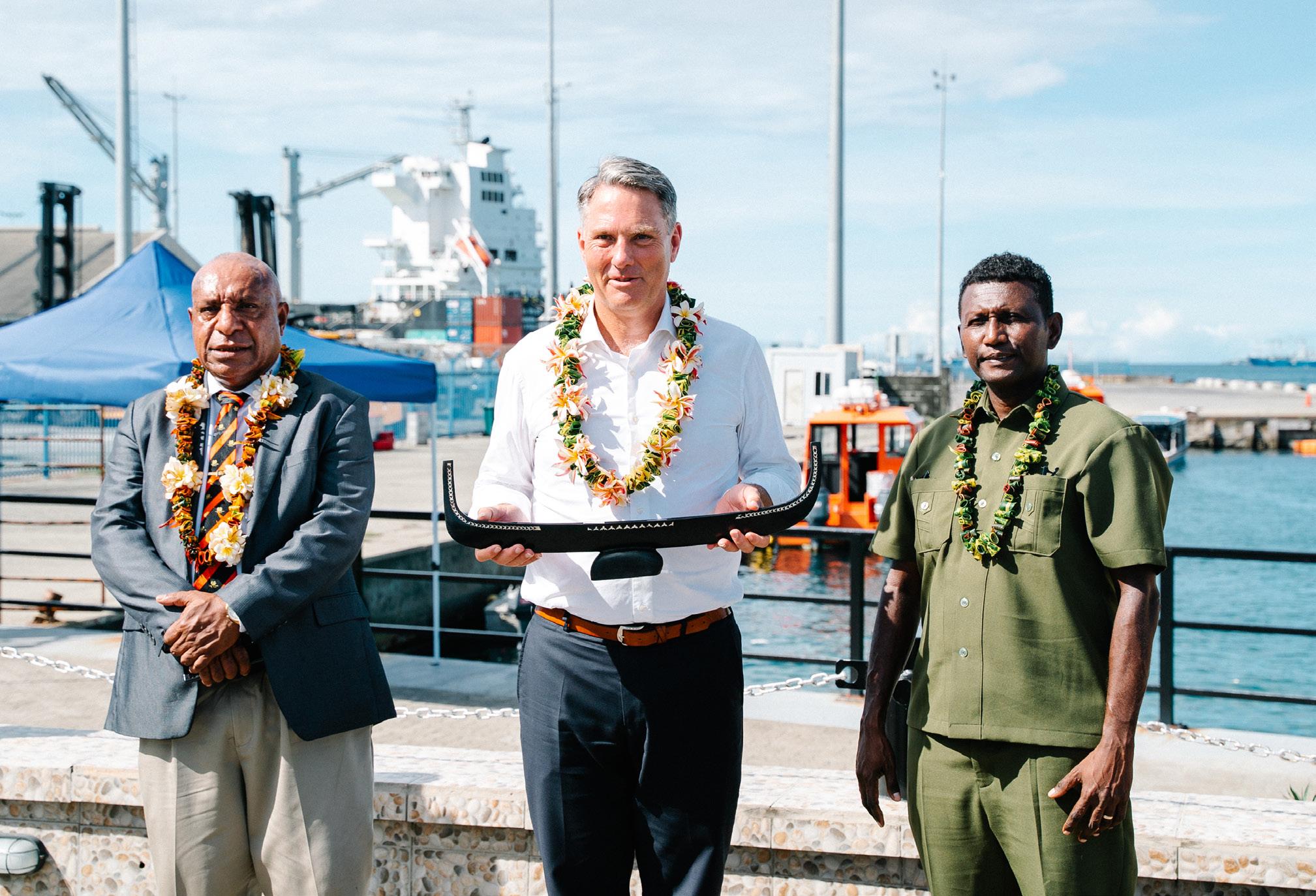
New Border Management System to Enhance Solomon Islands' Security and Economic Growth
THE SOLOMON Islands is set to experience a significant boost in both security and economic development with the introduction of a new Border Management System (BMS), funded by the Australian Government. Announced by Australian Deputy Prime Minister and Minister for Defence, Richard Marles, this initiative is a part of a Pacific trilateral partnership involving Australia, Papua New Guinea, and the Solomon Islands. Australia has committed over SBD18 million to establish the BMS, which aims to maximize the economic benefits of migration while maintaining the integrity and security of the Solomon Islands' borders. This modern system will revolutionize the country’s immigration operations by digitizing visa processing and managing border entries and exits, thereby improving processes for increased revenue collection.
The development of the BMS is the result of extensive collaboration among the governments of Australia, Papua New Guinea, and the Solomon Islands. The Australian Border Force (ABF) provided essential guidance, while the Papua New Guinea Immigration and Citizenship Services Authority customized the
infrastructure to suit the specific needs of the Solomon Islands. Minister of Police, National Security, and Correctional Services (MPNSCS), Jimson Tanangada, acknowledged the collaborative efforts and the milestone achievement. "The BMS system, which we are witnessing today, is indeed the result of extensive work between your government, the Papua New Guinea government, and the Solomon Islands," he stated.
The new BMS is designed to strengthen border security and create an environment conducive to economic growth. By deterring illegal activities such as human trafficking, drug smuggling, and transnational crime, the system will ensure that the Solomon Islands’ borders remain secure. At the same time, it will facilitate legitimate trade and travel, boosting the tourism and hospitality sectors.
Minister Tanangada highlighted the importance of the BMS in addressing security challenges and enhancing economic opportunities. "The border management system is highly valued as it provides solutions to many of our security challenges," he said. "It will specifically address our many unanswered security
www.pacifictenders.com < APRIL - JUNE / ISSUE 16 36
(L-R) PNG High Commissioner H.E. Moses Kouni, Australia DPM Hon. Richard Marles and SI Police Minister Jimson Tanagada.
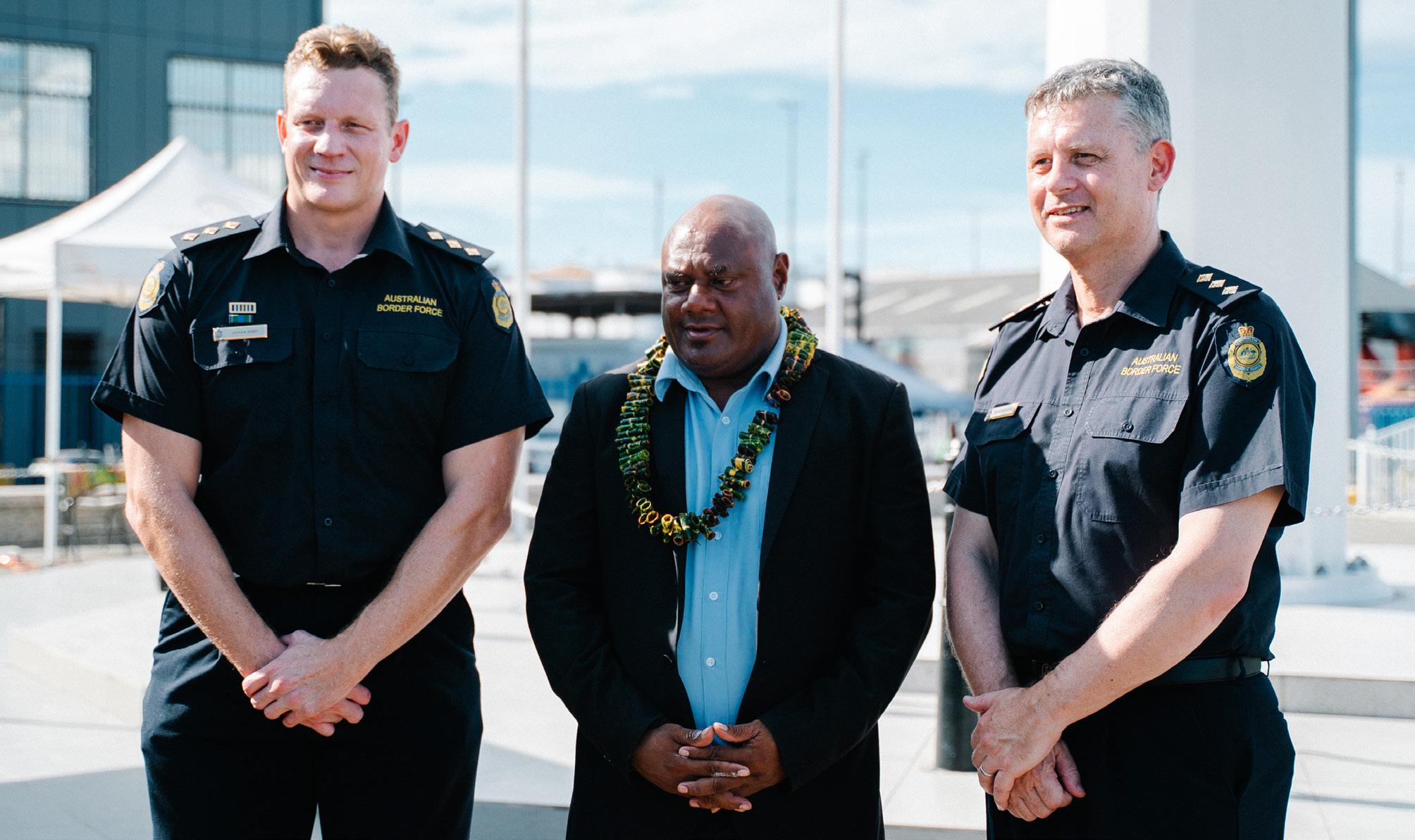
domain challenges in the region."
The BMS is scheduled for full implementation by mid-2025, with an online visa system expected to go live towards the end of 2024 or early 2025. This new visa regime will streamline immigration processes, making it easier for tourists and business travelers to enter the Solomon Islands. The anticipated reforms will help immigration and enforcement officers make informed decisions electronically, ultimately creating opportunities to boost tourism and hospitality services while maintaining border security.
The Solomon Islands Government is optimistic about the
broader impact of the BMS. It is expected to increase trade, revenue, and support labor and immigration reforms. By improving the efficiency and visibility of border management, the BMS will create a more attractive environment for investment and economic development.
The introduction of the new Border Management System marks a significant advancement for the Solomon Islands. This project not only enhances national security but also paves the way for substantial economic growth. Through continued collaboration with Australia and Papua New Guinea, the Solomon Islands is poised to achieve a more secure and prosperous future.
 Picture (Center) Acting Director of Immigration Chris Akosawa and two Borer and Customs Officers from Australia.
Picture (Center) Acting Director of Immigration Chris Akosawa and two Borer and Customs Officers from Australia.
INFRASTRUCTURE DEVELOPMENT / INDUSTRY
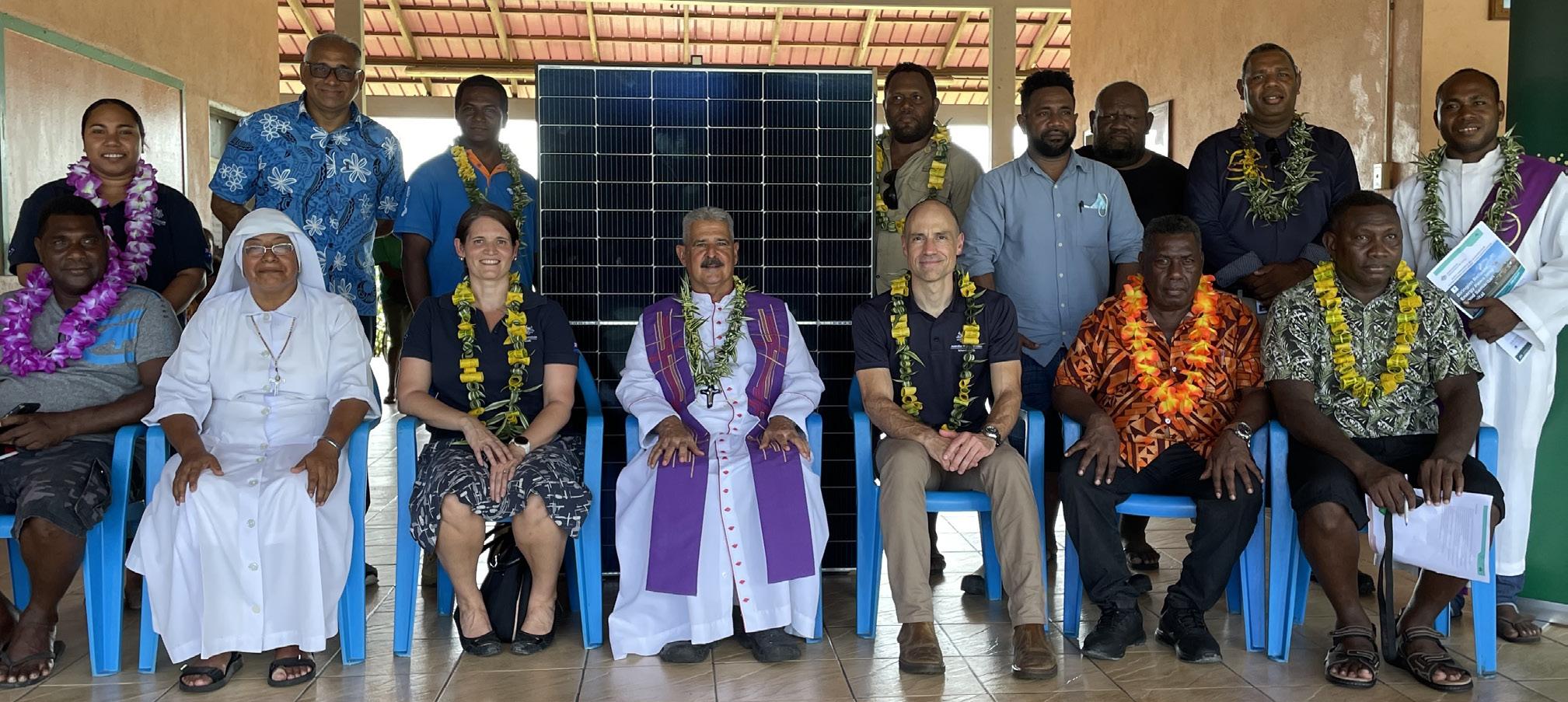
Powering Healthcare in Solomon Islands
AUSTRALIA'S SUPPORT is bolstering the healthcare system through improved energy security in the rural community of Tetere, Solomon Islands.
The Australian Infrastructure Financing Facility for the Pacific (AIFFP), through its Pacific Climate Infrastructure Financing Partnership (PCIFP) and in partnership with Superfly Limited, is investing SBD 1.5 million to install a solar hybrid system that will provide sustainable and consistent energy for the Good Samaritan Hospital.
The Good Samaritan Hospital in Tetere provides essential healthcare services for over 43,000 people, with a focus on maternity care and child health services. Located outside the Honiara electricity grid, the hospital currently relies on dieselfueled electricity generation, which is expensive, unreliable, and contributes to climate change. This poses risks to patients and staff due to inconsistent power and pollution.
Through this two-year partnership, local electrical company Superfly will install a solar-hybrid system to meet the hospital's energy needs, enabling the community to access a safer and more resilient healthcare setting.
Superfly will also train hospital staff to monitor and maintain the system and use data-driven insights to develop scalable models for future fuel-switching projects in other remote communities in Solomon Islands and the wider Pacific.
At a community event announcing the project, Australia's Deputy High Commissioner to Solomon Islands, Mr. Andrew Schloeffel, said, "Australia is very proud to be part of a project that supports the Good Samaritan Hospital to reduce its reliance on costly, imported diesel fuel."
By switching to the solar hybrid system, the partnership is projected to reduce 510 tonnes of CO2 emissions over 10 years.
The PCIFP expands the AIFFP's climate investments by partnering with businesses to deliver reliable and sustainable renewable energy to remote and rural communities in the Pacific and Timor-Leste.
This initiative aligns with Solomon Islands' Long-Term Low Emissions Development Strategy, which aims to increase electricity access outside of Honiara from 4.9% to 40% by 2025, working towards 100% access to electricity by 2050.

APRIL - JUNE / ISSUE 16
Australia provides support for Tetere and Good Samaritan Hospital.











 IBy DAVID SPRING PT COLUMNIST Sydney, Australia
IBy DAVID SPRING PT COLUMNIST Sydney, Australia































 Dion Palu Managing Director Quality Solutions Pacific
Dion Palu Managing Director Quality Solutions Pacific








 Picture (Center) Acting Director of Immigration Chris Akosawa and two Borer and Customs Officers from Australia.
Picture (Center) Acting Director of Immigration Chris Akosawa and two Borer and Customs Officers from Australia.



